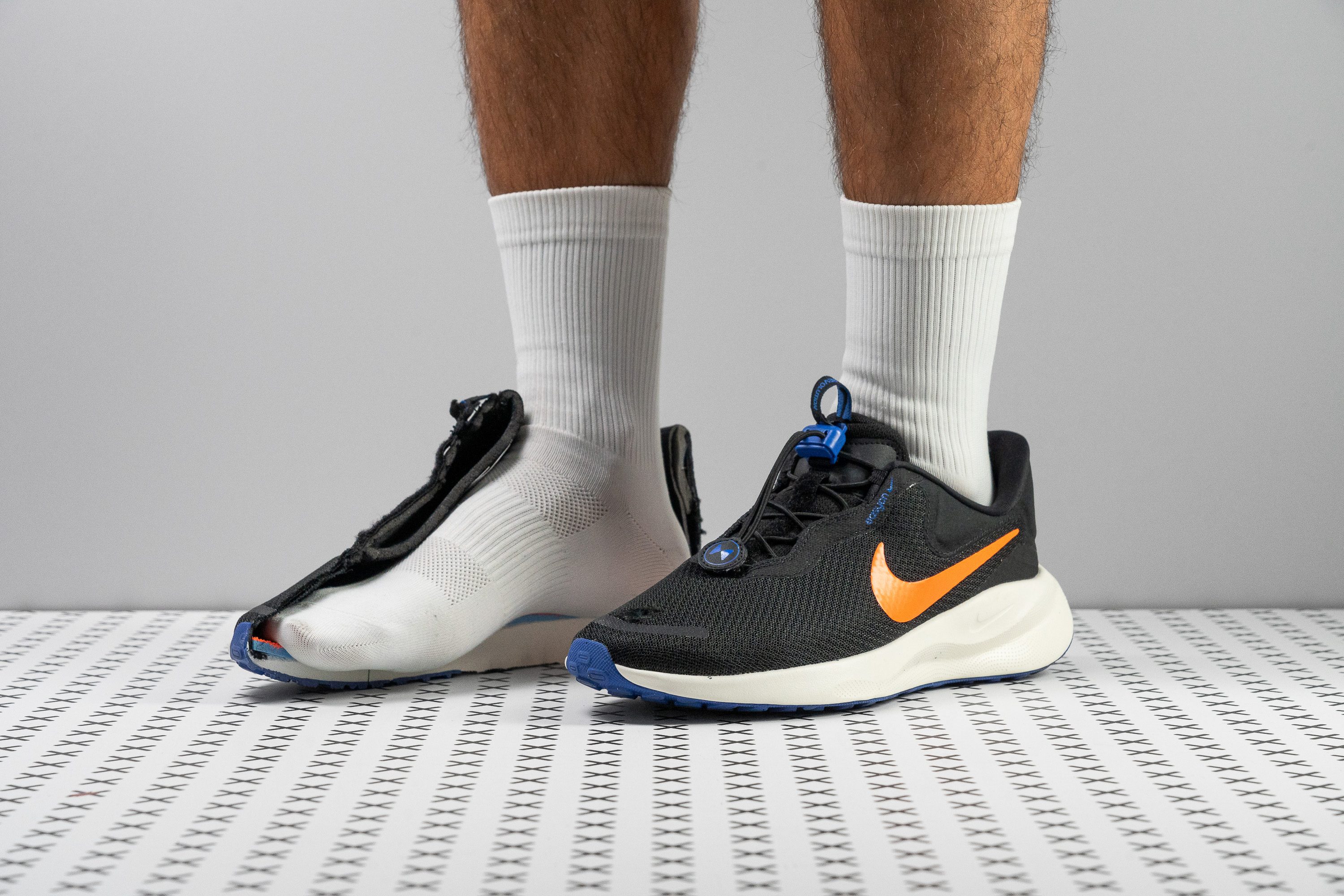Our verdict
Pros
- Flexible enough for walking and easy running
- High breathability
- EasyOn system
- Incredible value
- Good stability
- Accesible for individuals with disabilities
- Same price as regular Revolution 7
- Great for heel strikers
Cons
- Limited durability of toebox mesh
- Firm midsole
- Thin forefoot cushioning
- Tapered, low-volume toebox
Audience verdict
Comparison
The most similar running shoes compared
+ + Add a shoe | |||||
|---|---|---|---|---|---|
| Audience score | 80 Good! | 77 Decent! | 83 Good! | 81 Good! | |
| Price | £60 | £65 | £130 | £80 | |
| Pace | Daily running | Daily running | Daily running | Daily running | |
| Shock absorption | - | Moderate | - | Low | |
| Energy return | - | Low | - | Low | |
| Traction | - | Moderate | - | Moderate | |
| Arch support | Neutral | Neutral | Neutral | Neutral | |
| Weight lab Weight brand | 9.7 oz / 275g | 9.3 oz / 265g 9.4 oz / 267g | 10.1 oz / 286g 10.4 oz / 295g | 10.5 oz / 298g 9.9 oz / 280g | |
| Drop lab Drop brand | 9.9 mm | 10.1 mm 10.0 mm | 11.6 mm 10.0 mm | 9.4 mm 10.0 mm | |
| Strike pattern | HeelMid/forefoot | Heel | Heel | HeelMid/forefoot | |
| Size | True to size | Slightly small | True to size | Slightly small | |
| Midsole softness | Balanced | Balanced | Soft | Firm | |
| Difference in midsole softness in cold | Normal | Small | Normal | Small | |
| Toebox durability | Decent | Decent | Bad | Bad | |
| Heel padding durability | Good | Good | Good | Bad | |
| Outsole durability | Decent | Good | Decent | - | |
| Breathability | Breathable | Moderate | Breathable | Moderate | |
| Width / fit | Narrow | Medium | Medium | Medium | |
| Toebox width | Narrow | Medium | Medium | Medium | |
| Stiffness | Moderate | Moderate | Stiff | Moderate | |
| Torsional rigidity | Moderate | Moderate | Moderate | Moderate | |
| Heel counter stiffness | Stiff | Moderate | Stiff | Moderate | |
| Heel lab Heel brand | 31.7 mm | 32.2 mm 32.0 mm | 33.6 mm 34.0 mm | 32.0 mm | |
| Forefoot lab Forefoot brand | 21.8 mm | 22.1 mm 22.0 mm | 22.0 mm 24.0 mm | 22.6 mm | |
| Widths available | Normal | NarrowNormalWideX-Wide | Normal | NormalWideX-Wide | |
| Orthotic friendly | ✓ | ✓ | ✓ | ✓ | |
| Season | SummerAll seasons | All seasons | SummerAll seasons | All seasons | |
| Removable insole | ✓ | ✓ | ✓ | ✓ | |
| Ranking | #310 Bottom 16% | #337 Bottom 9% | #265 Bottom 28% | #288 Bottom 22% | |
| Popularity | #327 Bottom 12% | #60 Top 17% | #160 Top 44% | #106 Top 29% |
Who should buy
After thorough testing of the Nike Revolution 7 in the lab and on the road, we concluded that:
- Triathletes on a tight budget or just beginning can start affordably with the Revolution 7 EasyOn.
- For individuals who dislike tying laces, Nike’s EasyOn system provides a quick-and-easy solution.
- This running shoe is the best accessible, budget-friendly choice for individuals with disabilities.
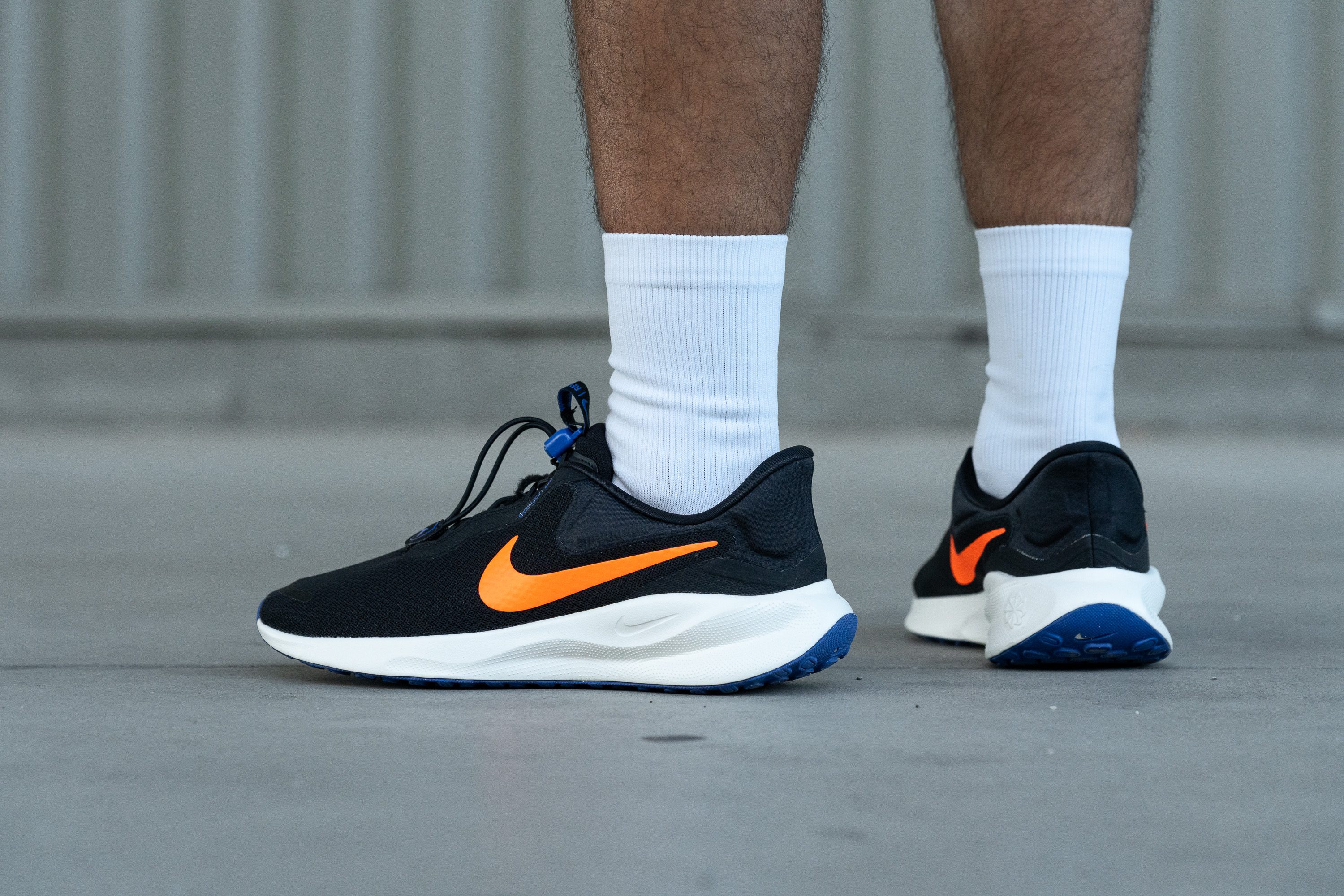
Who should NOT buy
We think that runners looking for a premium, cushioned experience should steer clear of the Revolution 7 EasyOn. In our testing, we found its Phylon midsole too firm compared to the Pegasus EasyOn, which offers a plush ReactX foam and higher-quality materials throughout. That upgrade, of course, comes with a higher price tag.
Additionally, we’re convinced that the thin forefoot cushioning on the Revolution 7 EasyOn might not suit some runners. If you’re in need of more foam underfoot without breaking the bank, we recommend the Saucony Axon 3.
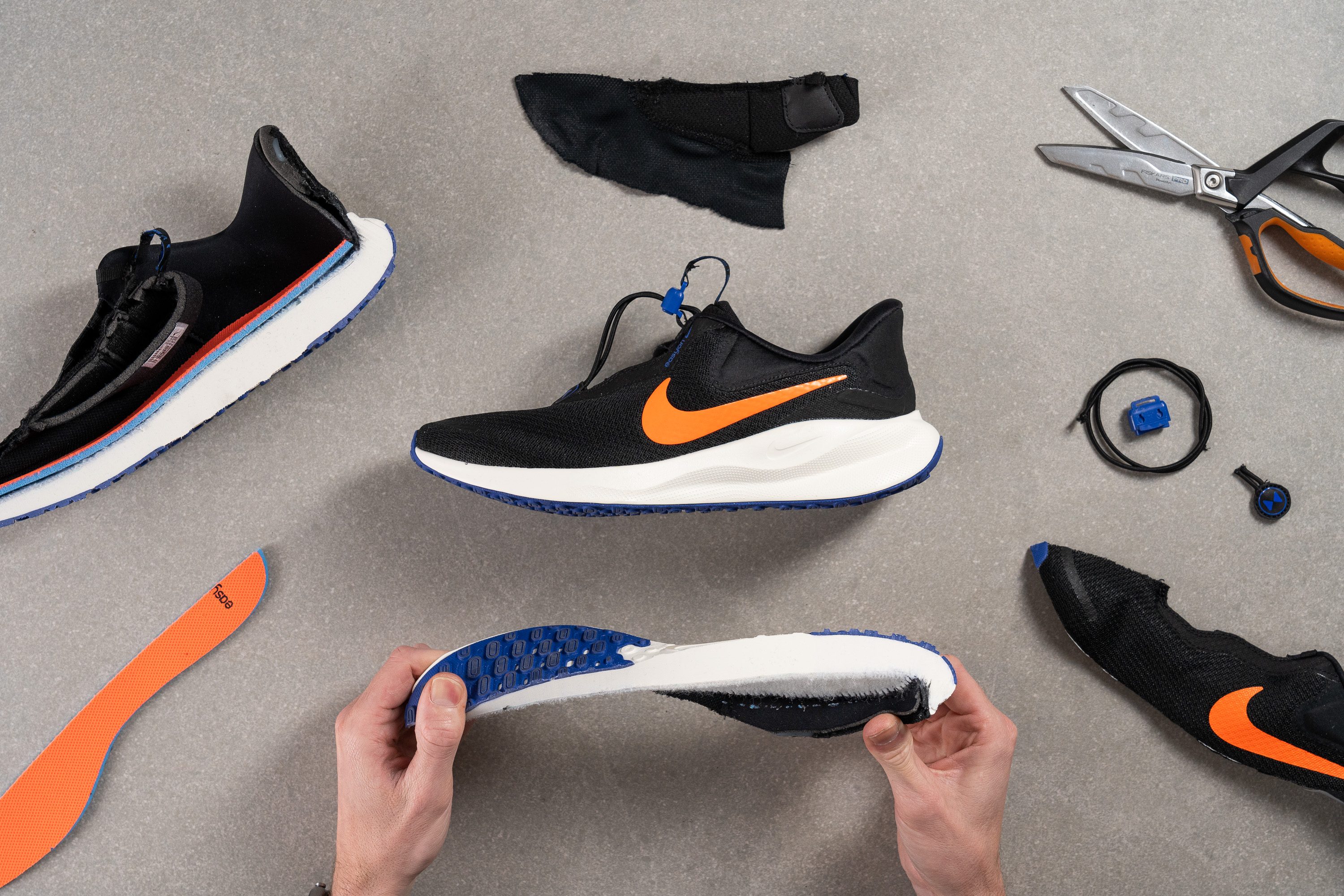
Cushioning
Heel stack
The Revolution 7 EasyOn shares the same concept as the Pegasus 41 and Pegasus EasyOn—keeping the same midsole and outsole while introducing an all-new upper design. Interestingly, this model retains its edition number too in its name, unlike the Pegasus.
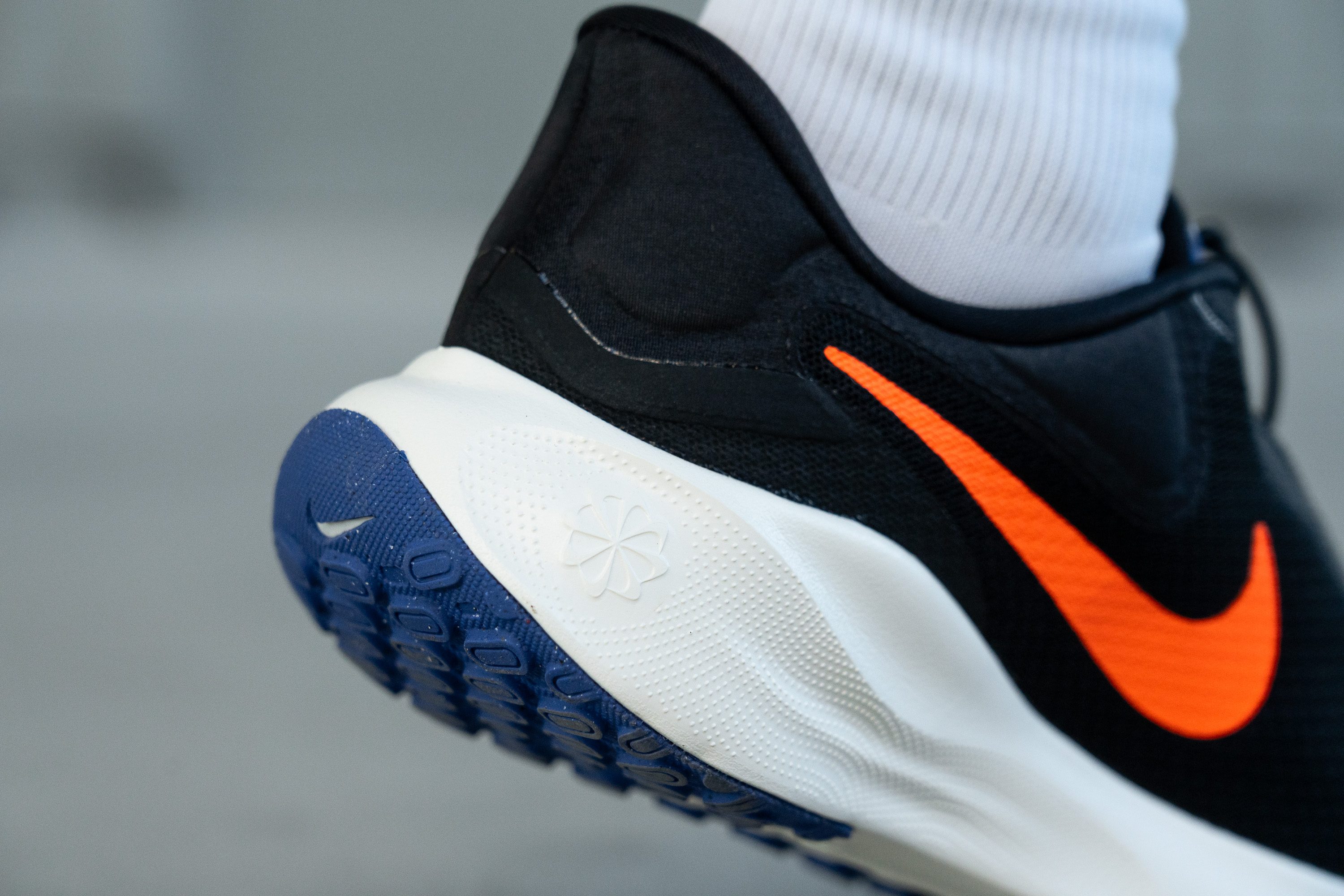
Therefore, we weren’t surprised to see that the heel stack remains largely unchanged from the non-EasyOn version, measuring a respectable 31.7 mm.
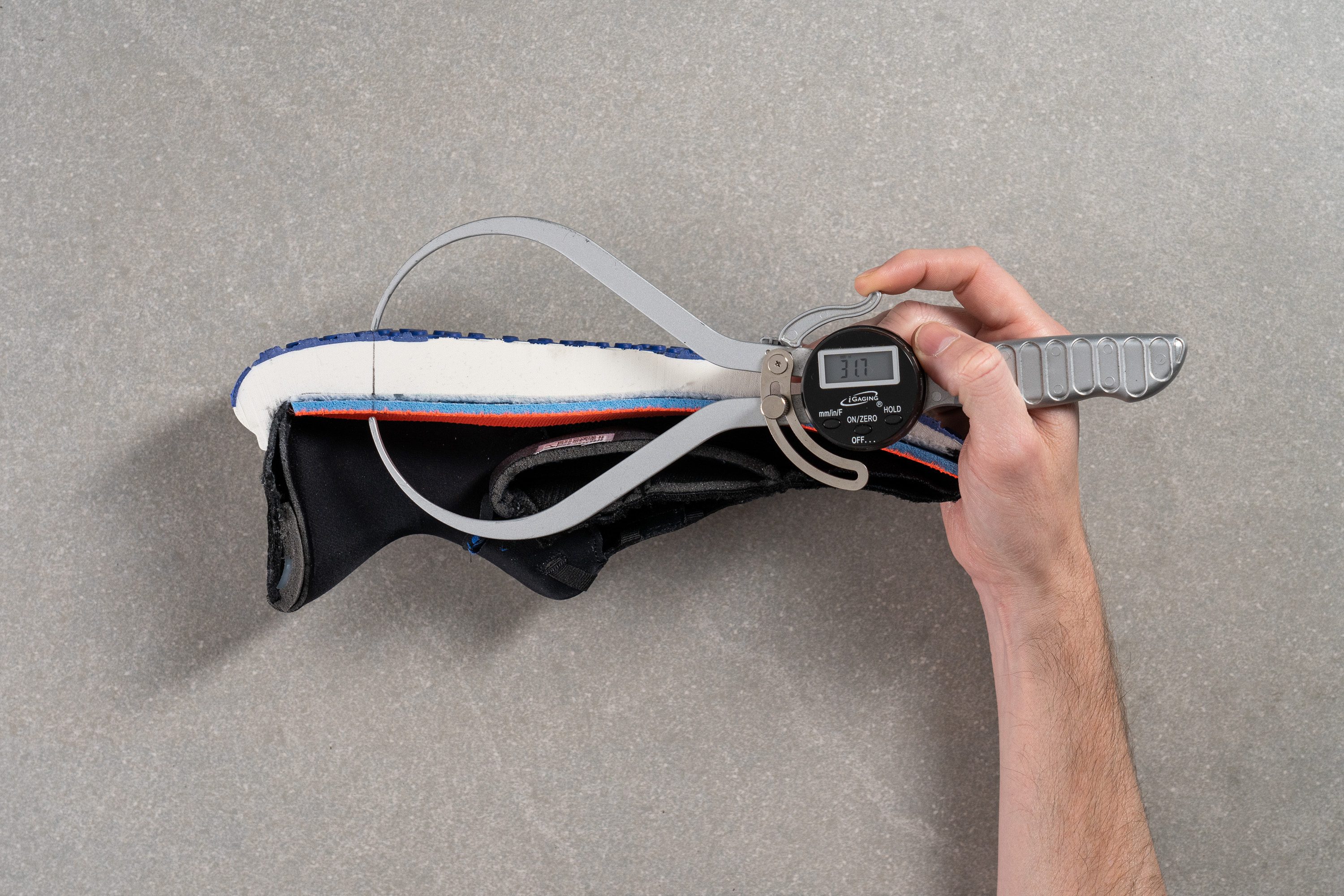
| Revolution 7 EasyOn | 31.7 mm |
| Average | 34.8 mm |
Forefoot stack
The forefoot is relatively thin at 21.8 mm, which might feel limited for heavier runners but should be sufficient for casual runs and walking—the intended purpose of this shoe. As expected, it’s nearly identical to the regular Revolution 7.

| Revolution 7 EasyOn | 21.8 mm |
| Average | 26.2 mm |
Drop
The Revolution 7 has consistently been a high-drop running shoe, and Nike delivers once again with a 9.9-mm heel-to-toe drop—remarkably close to the official 10-mm spec. Kudos to Nike for such impressive precision!

| Revolution 7 EasyOn | 9.9 mm |
| Average | 8.6 mm |
Midsole softness
We found that the Revolution 7 EasyOn retains the same Phylon EVA-based foam, which felt noticeably firmer than the Pegasus during runs.
Using our Shore A durometer, we measured a softness of 27.1 HA. So, if you’re after a plush, cushiony experience, this isn’t the shoe for you. And sorry, Nike, but we can’t agree with the marketing claim (verbatim) that the Revolution 7 EasyOn’s “foam midsole delivers a soft, smooth ride.” Mmm… not quite, look at our video!
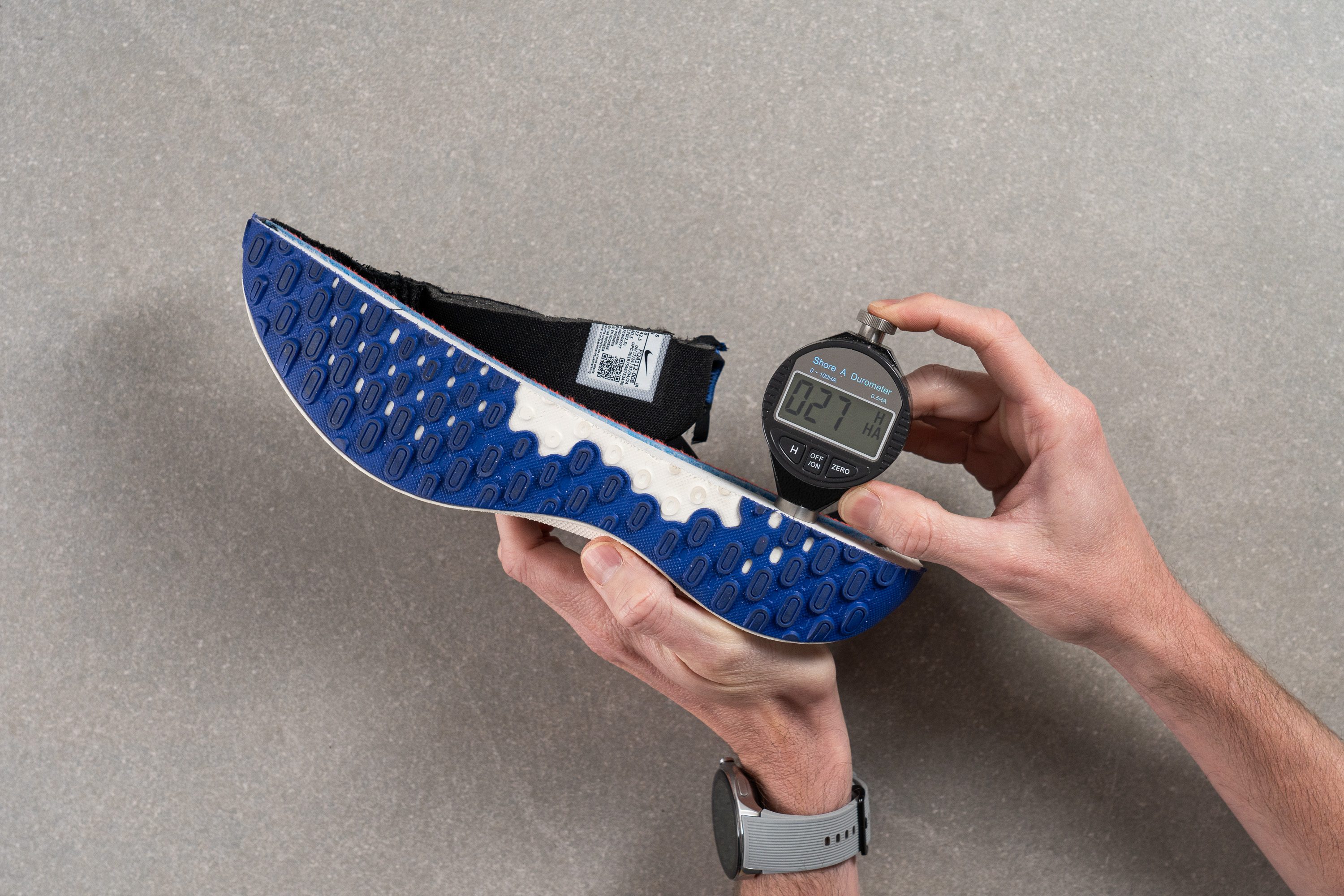
| Revolution 7 EasyOn | 27.1 HA |
| Average | 20.4 HA |
Rocker
In our experience, as with most daily trainers, the rocker feature in this shoe isn’t overly prominent—creating a subtle rather than dramatic forward-rolling effect. However, it follows recent Nike updates with a more defined heel curvature to support rearfoot strikers.
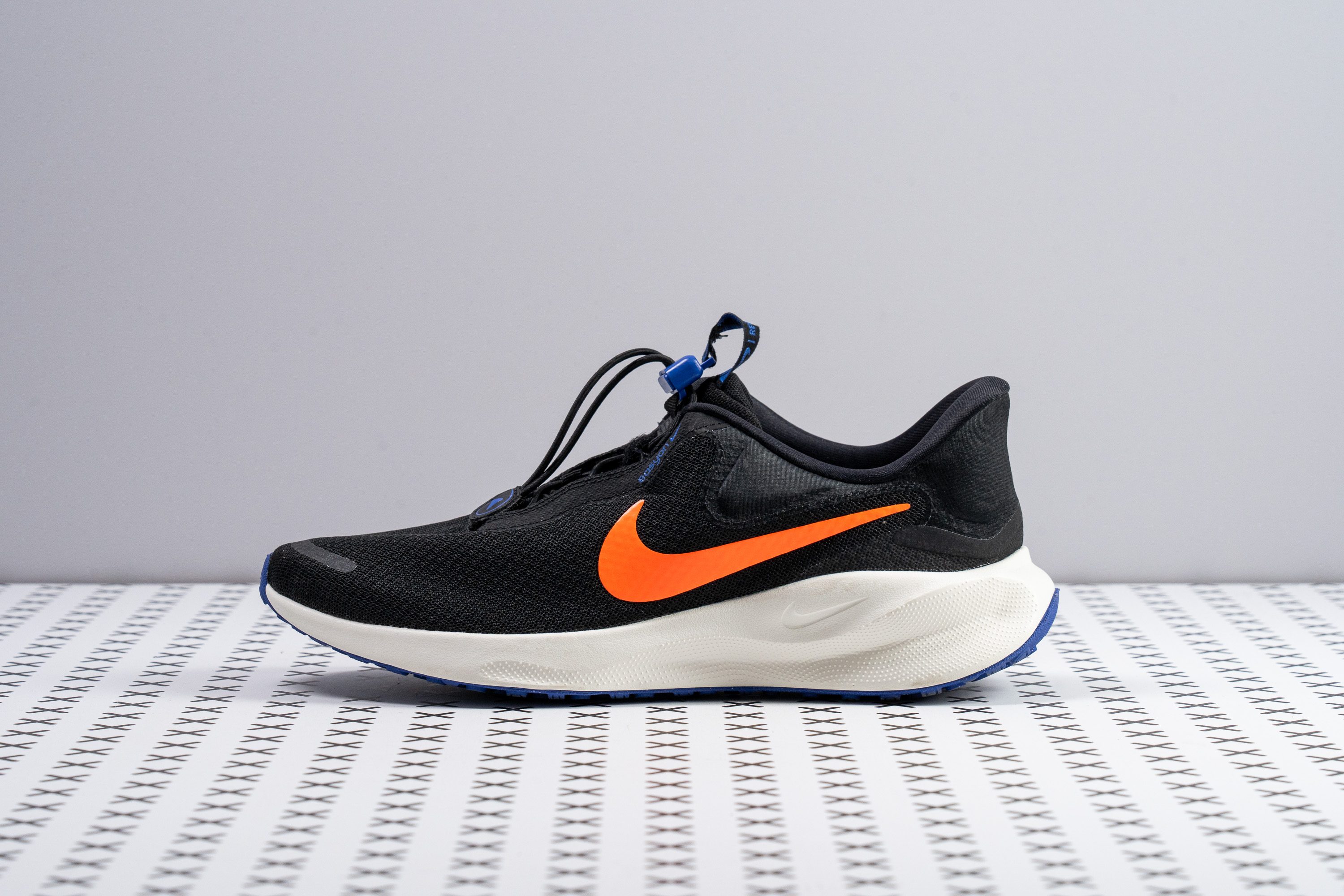
Size and fit
Size
Nike Revolution 7 EasyOn fits true to size (35 votes).
Width / Fit
The EasyOn version of the Revolution 7 felt comfortable yet slightly restricted—not the most spacious fit we’ve seen, that's for sure.
To check how the shoe stacks up against the average, we created a gel mould of its interiors and used a digital calliper to measure its dimensions.
The widest part of the mould came in at 92.6 mm, which is slightly below the average indeed. People with medium-to-narrow feet can achieve a proper fit in this Nike shoe, but those who need more space may prefer the regular Revolution 7, which is available in alternative widths - wide and extra wide.
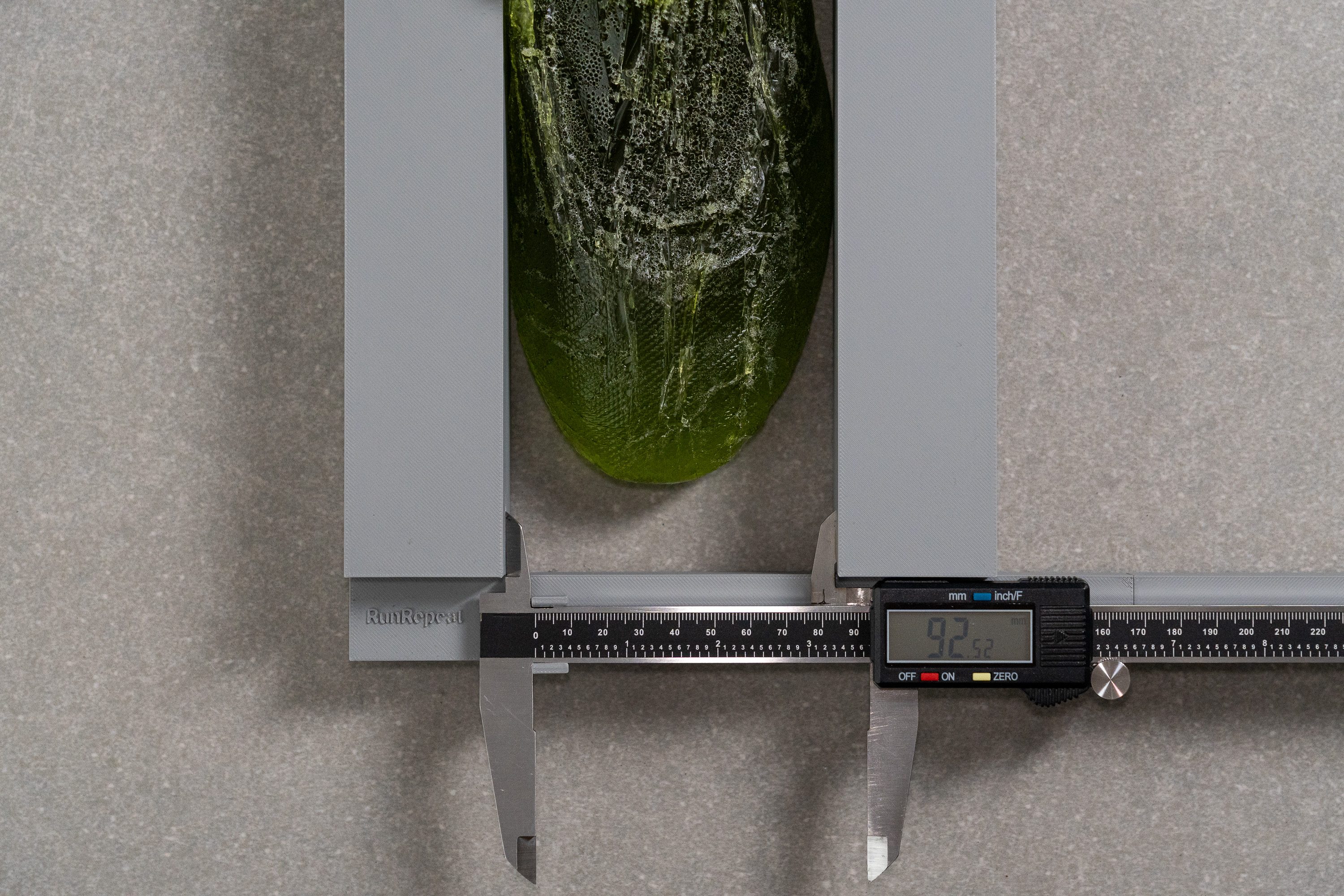
| Revolution 7 EasyOn | 92.6 mm |
| Average | 95.1 mm |
Toebox width
The shoe also gets proportionally narrower towards the toes showing another below-average width of 70.5 mm near the big toe. Definitely a close-fitting experience for those with medium-width feet.

| Revolution 7 EasyOn | 70.5 mm |
| Average | 73.3 mm |
Toebox height
We also found the shoe's vertical space rather moderate with a toebox height of 25.3 mm.
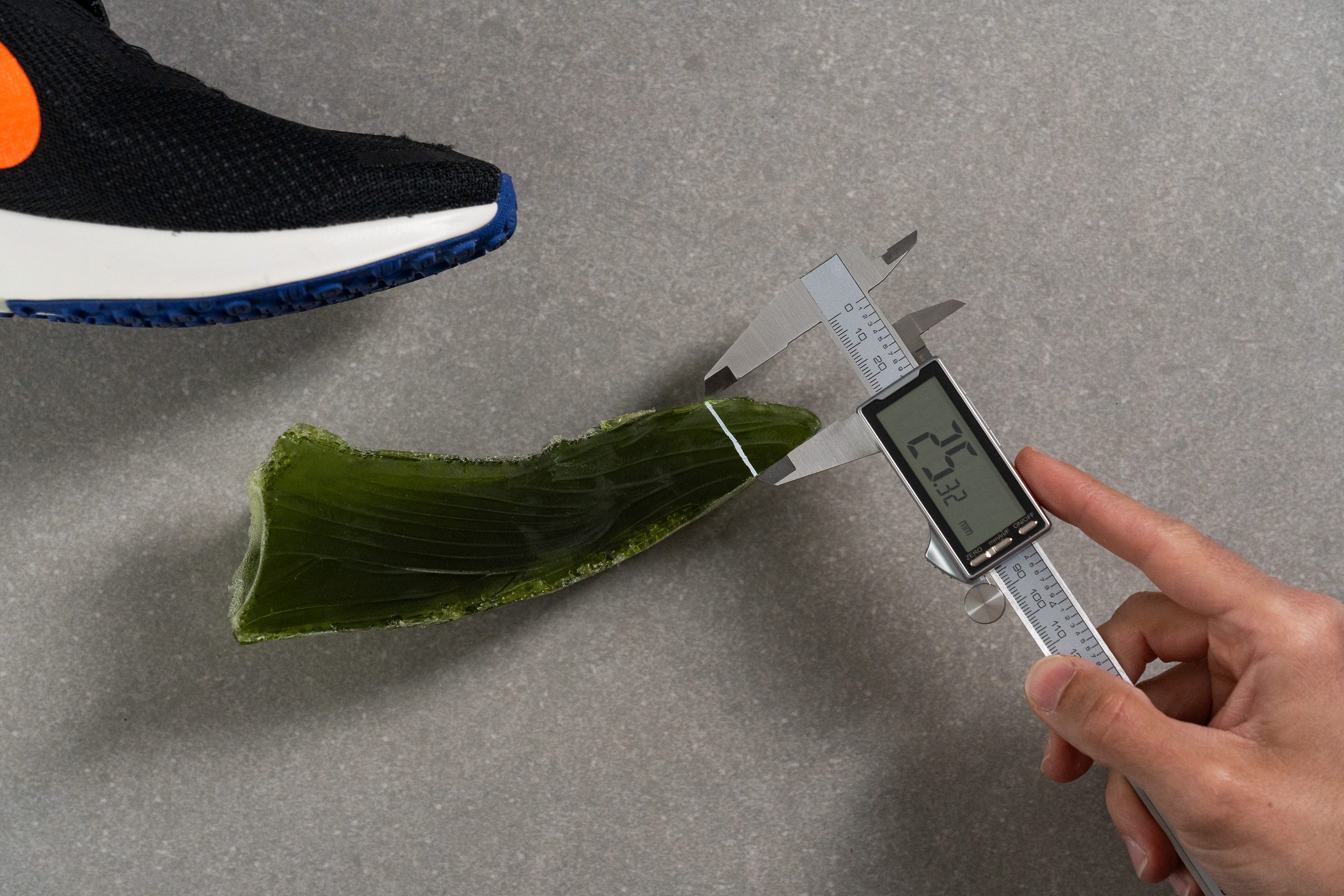
Soft mesh material is the only thing that prevents it from feeling too restrictive.
| Revolution 7 EasyOn | 25.3 mm |
| Average | 27.1 mm |
EasyOn
EasyOn is a technology created by Nike that's designed to make slipping into shoes faster and smoother.
For many individuals with disabilities, we believe this feature is truly game-changing, offering the freedom to put on shoes independently without assistance. It allows for hands-free foot entry and requires only one hand to operate the pull-and-release closure system.
The heel features a collapsible design that springs back into place after hands-free entry, ensuring a secure fit once your foot is inside. Afterward, you simply pull the tab and attach it to the Velcro strap—locking everything in place with one quick motion. Is that simple.
However, we found that the EasyOn system in this shoe operates a bit less smoothly than in the Pegasus EasyOn due to the tongue design. This isn’t surprising, though, as the Peg costs twice as much!
Flexibility / Stiffness
The trend of wearing running shoes as everyday fashion took off in the 70s and 80s, led largely by Nike’s Cortez and Air Max and Adidas’ Stan Smith, blending sportswear with casual style. Certainly, the Revolution 7 EasyOn may not reach the iconic status of those models, but it effectively meets the needs for a low-cost option.
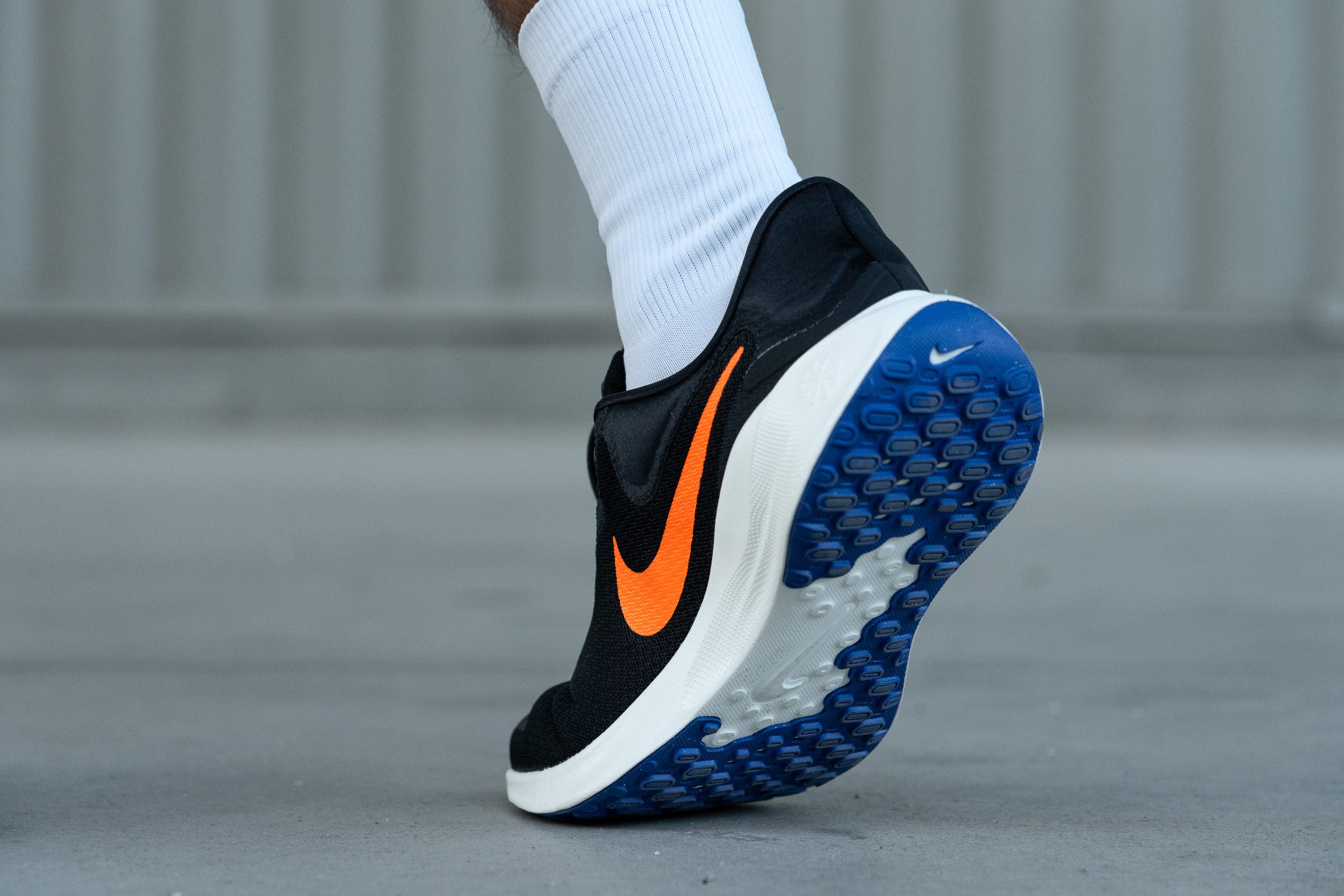
Indeed, most budget-friendly running shoes are fit for both runs and walks. And to achieve this, flexibility is key.
Fortunately, the Revolution 7 EasyOn flexes like a yoga instructor, requiring only 15.3N of force to bend it to 90 degrees. This makes it an excellent choice for walking too!
This test follows an older methodology, which is why you don't see recently tested shoes in the chart. Results from different methodologies can not be compared.
| Revolution 7 EasyOn | 15.3N |
| Average | 28.1N |
Weight
While the Pegasus EasyOn gained a bit of heft over its standard counterpart, we’re pleased to report the Revolution 7 EasyOn is a touch lighter than its sibling. At 9.7 oz (275g), it's only 0.2 oz (6g) less, but still good news!
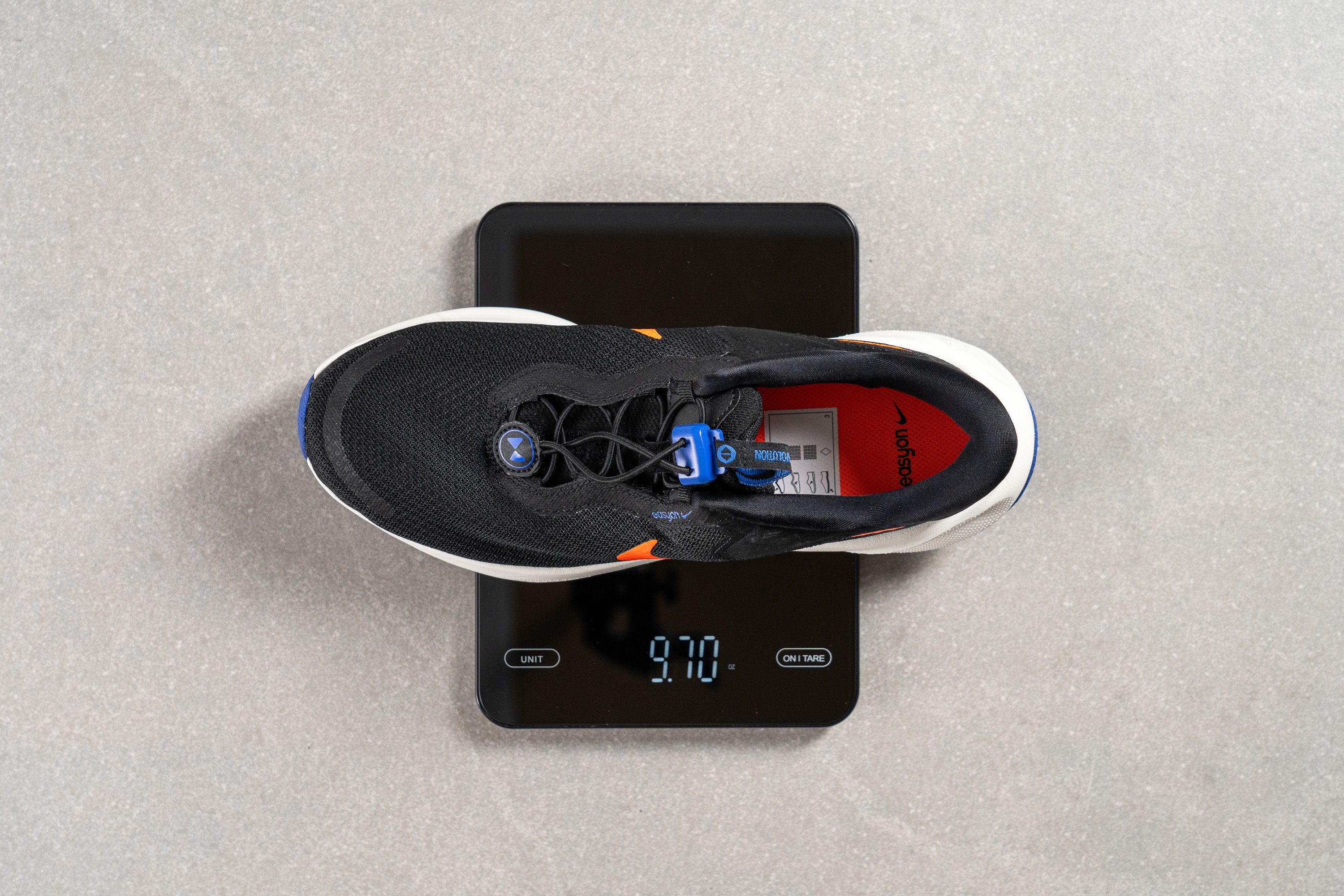
| Revolution 7 EasyOn | 9.7 oz (275g) |
| Average | 9.3 oz (264g) |
Breathability
The excitement-free black colorway we purchased—it was the only option available—initially made us question the shoe’s breathability, especially without visible ventilation holes. However, we were pleasantly surprised by the performance.
During our smoke test, airflow through the toebox was incredible, with smoke escaping rapidly, easily earning a 5/5 in breathability. To further test it, we used a powerful LED light to see how it penetrated the upper, and it shone through with ease, even without big ventilation holes across the toebox.
Examining the upper under a microscope, we discovered the secret to its excellent ventilation—a network of thousands of tiny gaps naturally created throughout the engineered mesh.
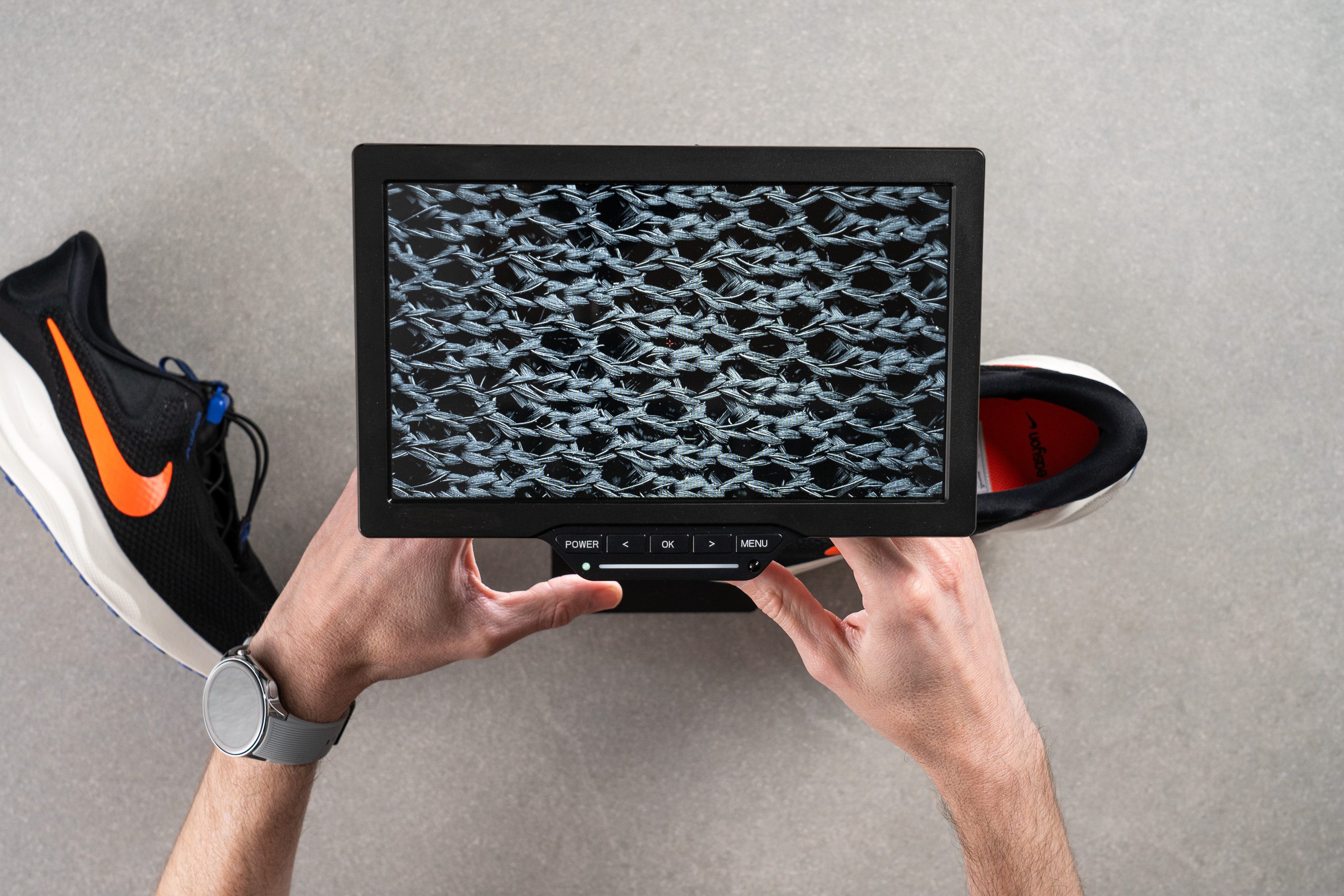
While these materials may not be luxurious at all—we didn’t expect that at this price point anyway—they truly fulfil the purpose of delivering breathability.
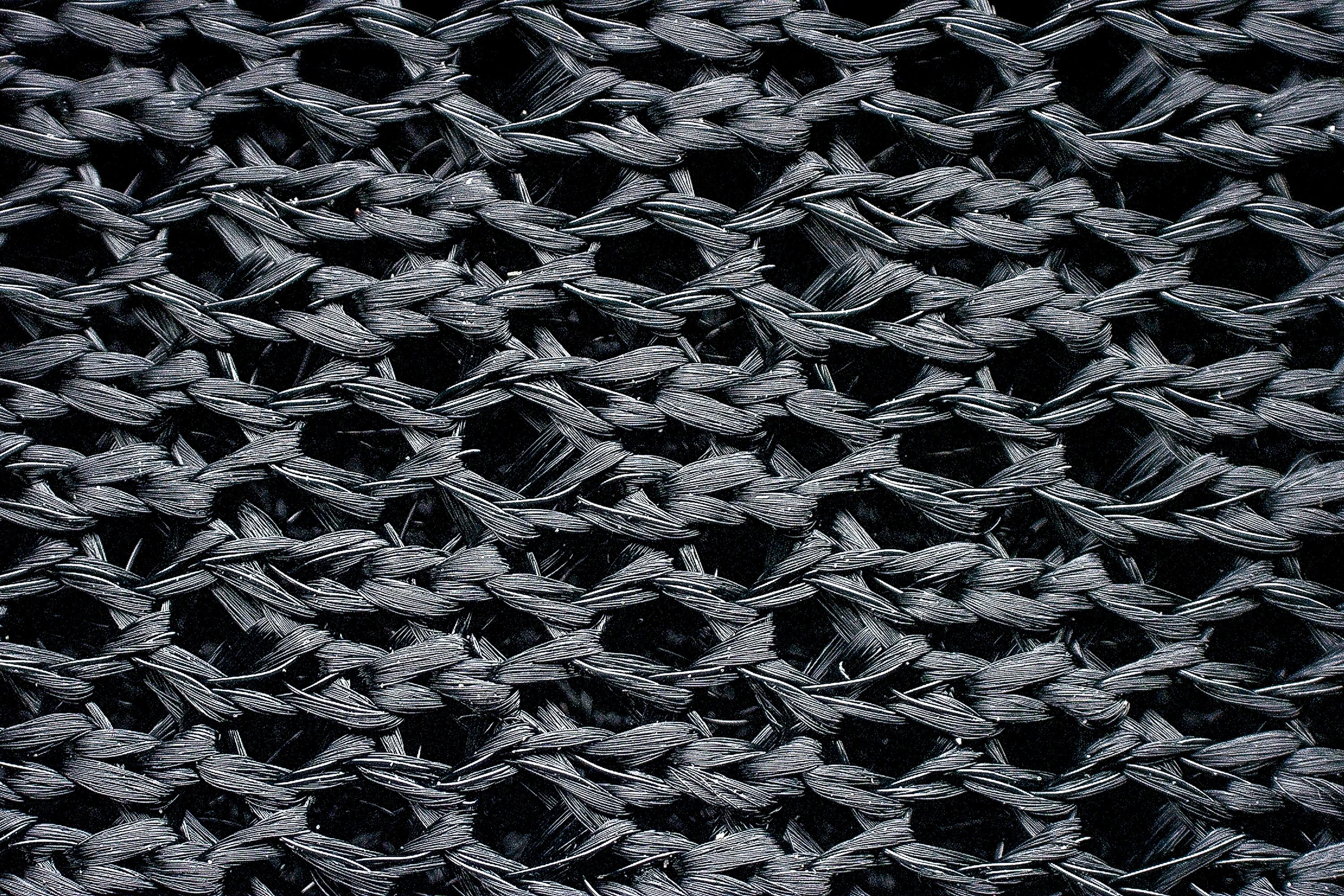
The upper does have slightly less padding than standard running shoes, likely a necessary adjustment to accommodate the EasyOn technology.
Overall, the Revolution 7 EasyOn delivers on ventilation incredibly well, balancing decent comfort and practicality—without sacrificing airflow.
| Revolution 7 EasyOn | 5 |
| Average | 3.7 |
Stability
Lateral stability test
The trade-off for the no-hands entry enabled by EasyOn technology is a slight compromise in stability, which is a bit lower than the standard Revolution 7. However, with its moderate stack height and firm foam, the difference feels minimal, particularly for those with larger feet who experience no wobbliness inside.
And for those with lower-volume feet, a useful trick could be swapping the stock insole for a thicker, third-party option.
Torsional rigidity
Since it shares the same outsole and midsole as the Revolution 7, we measured identical torsional rigidity at 3/5. No adjustments here, and nothing particularly noteworthy in this area.
| Revolution 7 EasyOn | 3 |
| Average | 3.5 |
Heel counter stiffness
The heel counter is noticeably different—a completely new design tailored to accommodate the EasyOn system.
We found it slightly stiffer than the regular Revolution 7, though the difference is subtle. However, take into account that the counter’s shape is entirely reworked, and the rigid piece extends a bit higher up the heel, which might cause discomfort for those sensitive to pressure in this area.
| Revolution 7 EasyOn | 4 |
| Average | 2.9 |
Midsole width - forefoot
We used our calipers to measure the shoe’s dimensions, starting with the forefoot. Our findings suggest that Nike maintains an average, familiar design. In fact, the forefoot spans 115.5 mm at its widest, keeping the Revolution 7 EasyOn comfortably within typical measurements.
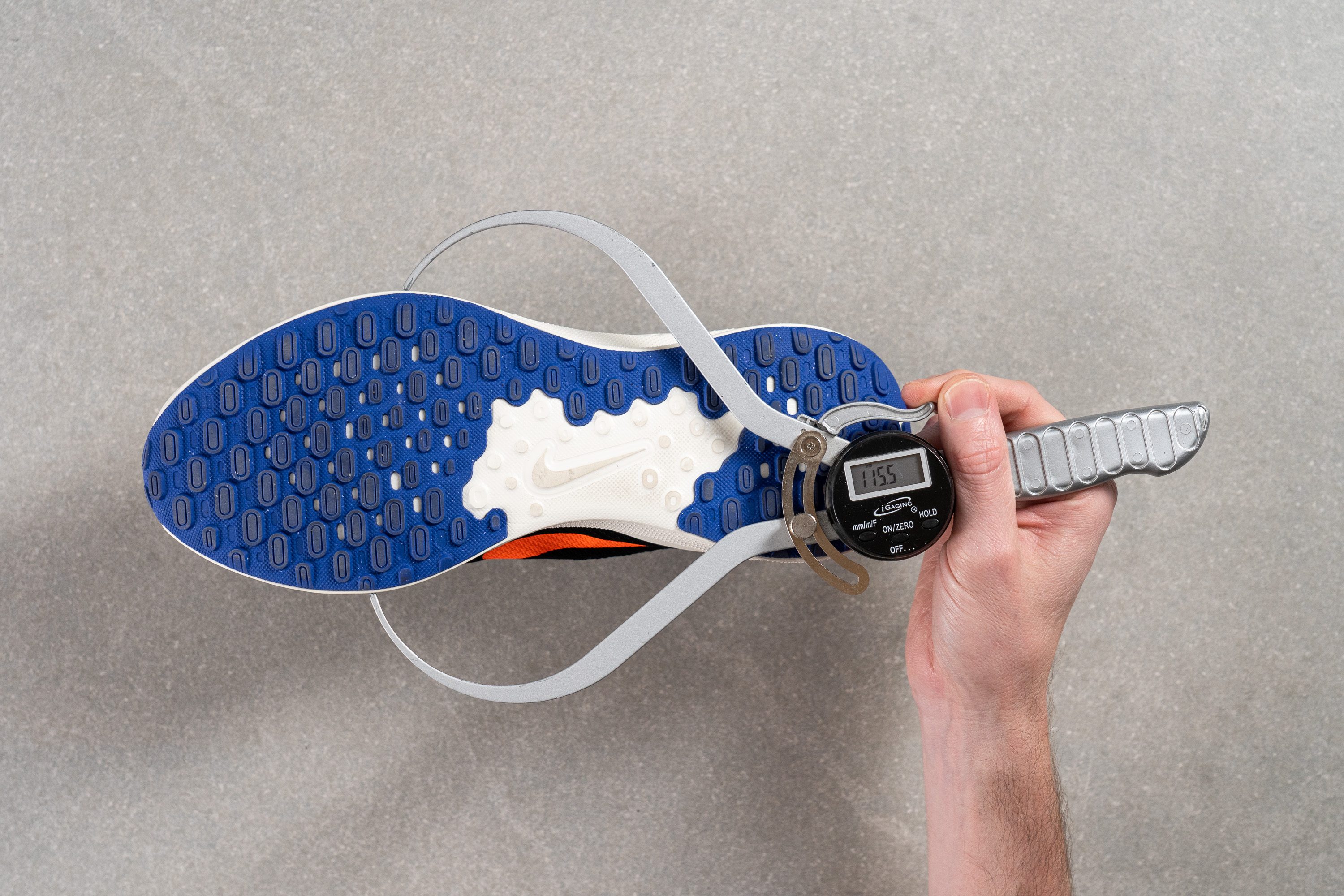
| Revolution 7 EasyOn | 115.5 mm |
| Average | 114.4 mm |
Midsole width - heel
In the heel, we found a width of 91.8 mm at its widest point, which should comfortably support heel strikers. We believe that any wider would make the shoe feel overly bulky and less nimble—especially for walking, which will likely be its main use for most individuals.

| Revolution 7 EasyOn | 91.8 mm |
| Average | 90.7 mm |
Durability
Toebox durability
The mesh doesn’t appear highly durable, and spotting a TPU overlay on the toe cap further supports this assessment.
After testing with the Dremel in this lab review, we gave it a 2/5 score—not the best but consistent with the type of engineered mesh Nike used for the Revolution 7 EasyOn. So, this result didn’t surprise us at all.
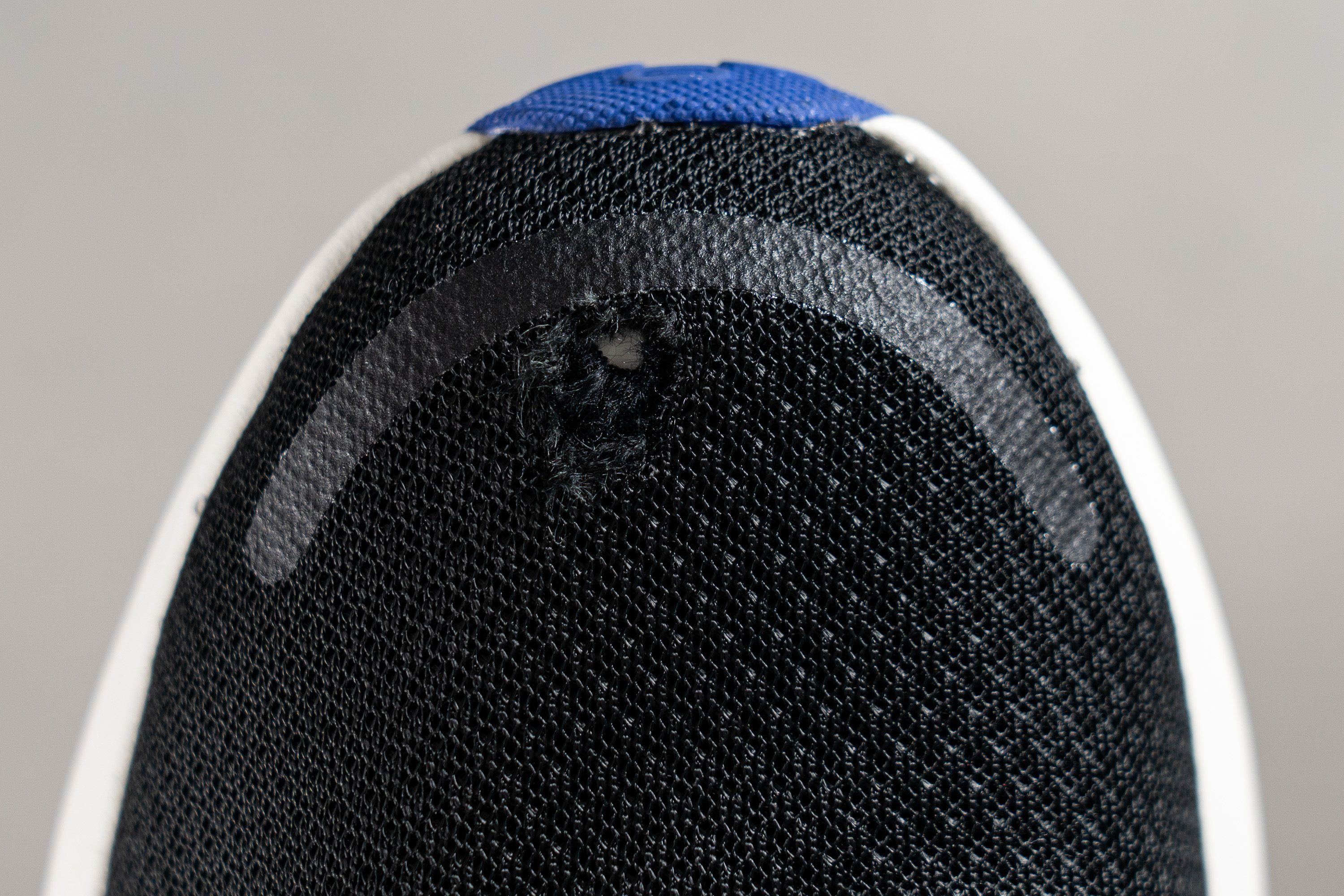
| Revolution 7 EasyOn | 2 |
| Average | 2.6 |
Heel padding durability
Each slip-on entry into the Revolution 7 EasyOn naturally generates friction as the foot glides against the heel. For this reason, without sufficient durability, the lining would wear down quickly, impacting both comfort and aesthetics.
A durable heel like this one (4/5) prevents early breakdown, making it a reliable choice for everyday wear.
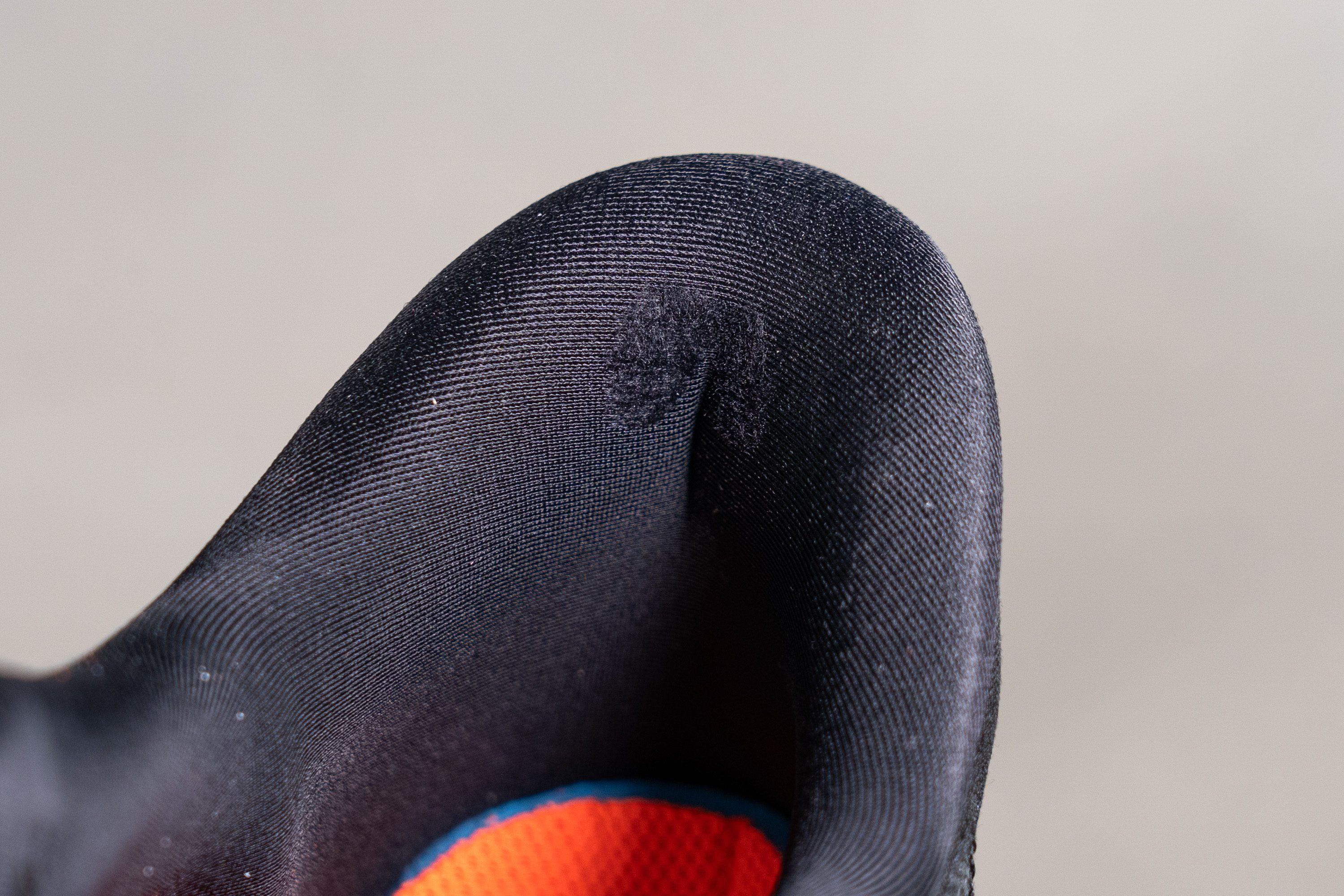
| Revolution 7 EasyOn | 4 |
| Average | 3.4 |
Outsole hardness
The Revolution 7 EasyOn shares the exact same outsole as its regular-laced sibling, with no design changes whatsoever other than the rubber colour.
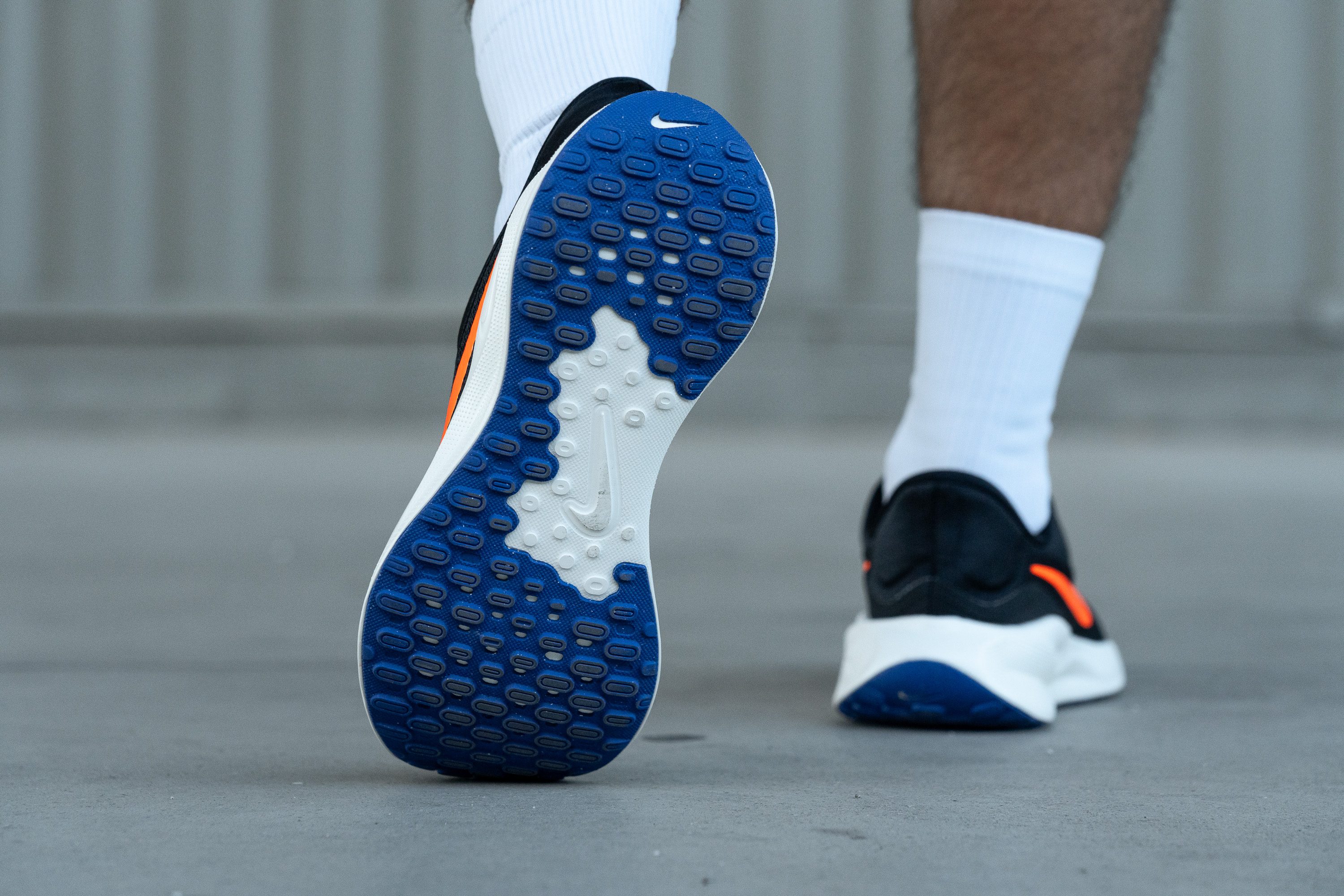
Using our Shore C durometer, we measured the rubber at 85.1 HC—quite firm, but typical for budget-friendly daily trainers, where durability takes priority over grip.
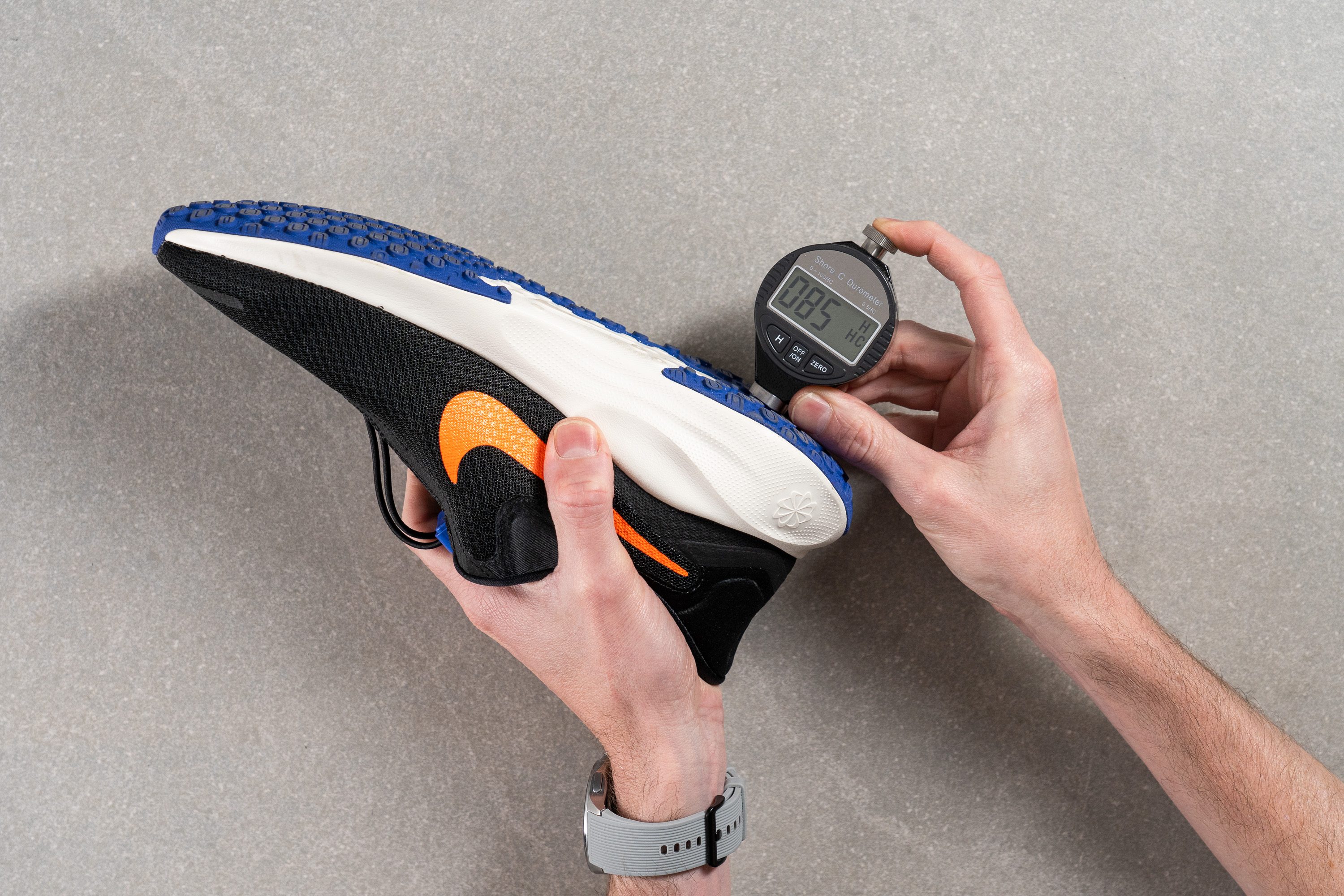
| Revolution 7 EasyOn | 85.1 HC |
| Average | 79.2 HC |
Outsole durability
In our third and final Dremel test, we raised the tool’s revolutions all the way to 10,000.
The resulting 1.3-mm dent wasn’t the performance we’d expect from such a firm rubber, but with a cheap shoe, some compromises in terms of quality are inevitable.
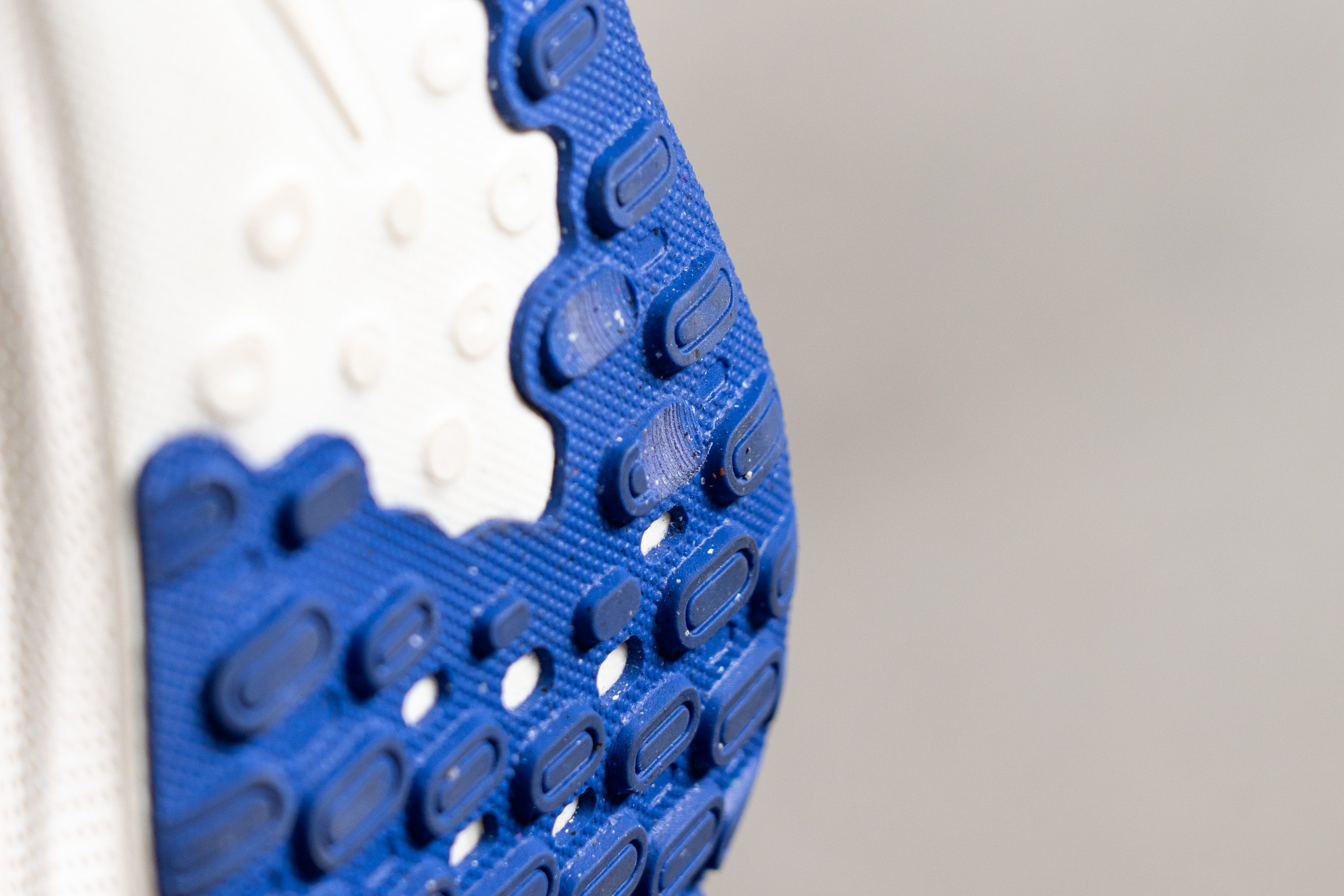
| Revolution 7 EasyOn | 1.3 mm |
| Average | 1.1 mm |
Outsole thickness
In our experience, the durability in our Dremel test fell slightly below expectations, though nothing too worrying—thanks to the solid 4.1 mm of rubber, which is a lot for a daily trainer.
We believe Nike could even reduce the thickness a bit in future versions to create a smoother, more cushioned ride.

| Revolution 7 EasyOn | 4.1 mm |
| Average | 3.2 mm |
Misc
Insole thickness
We measured the insole at just 4.0 mm with our calipers—a bit thinner than what’s typical in running shoes.
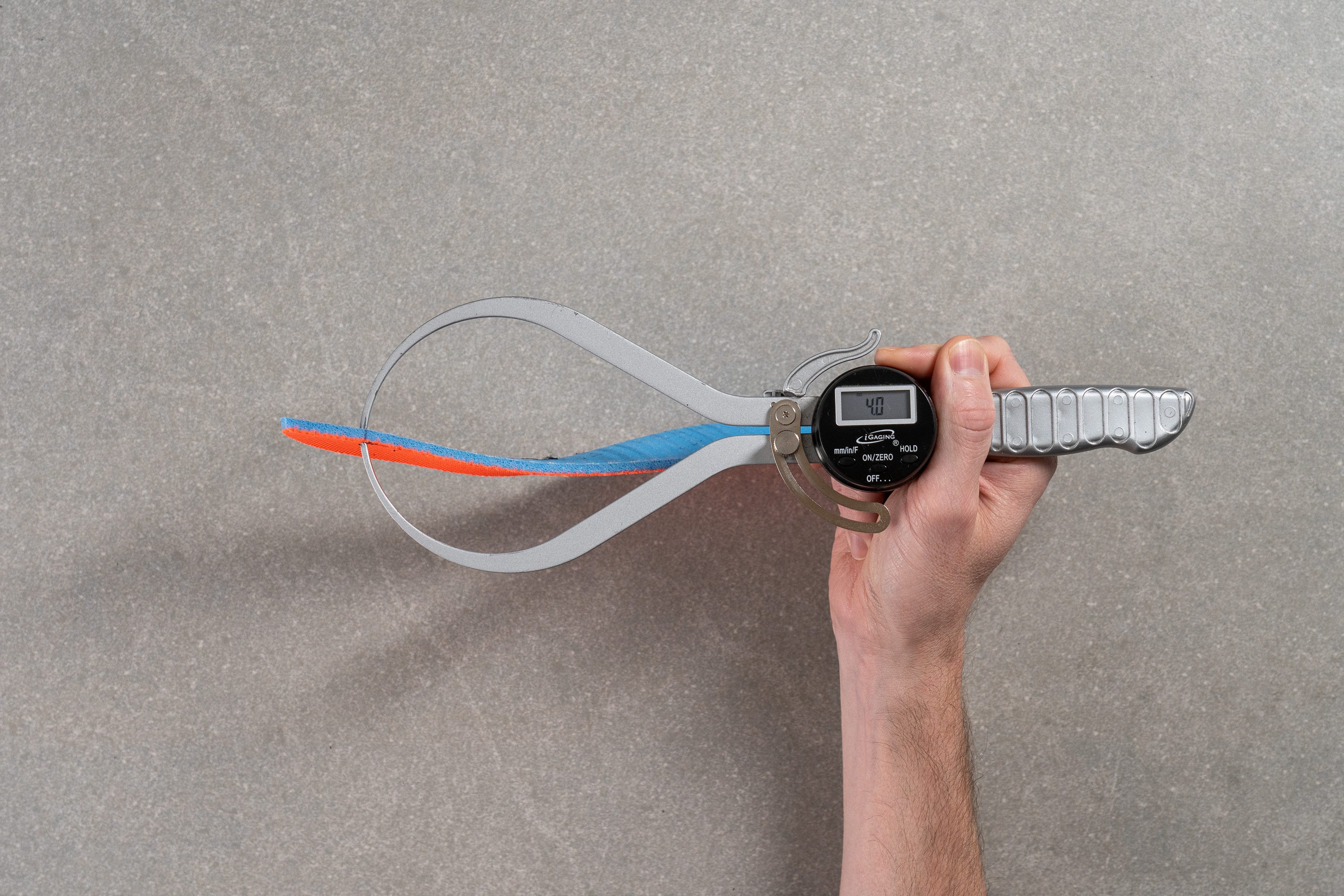
| Revolution 7 EasyOn | 4.0 mm |
| Average | 4.5 mm |
Removable insole
The insole is removable and quite basic, with no standout features. Replacing it for added comfort or support wouldn’t be a bad idea at all.
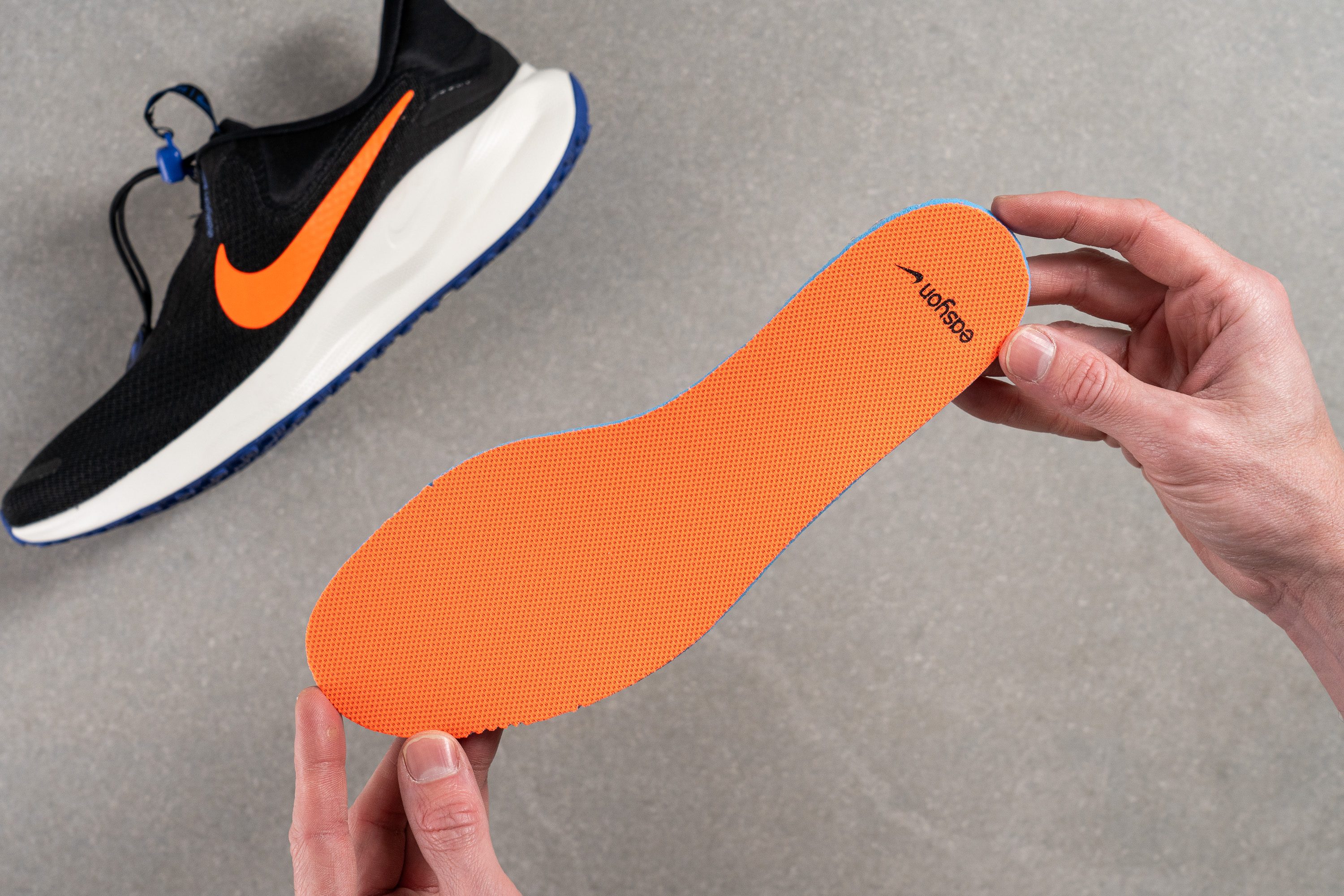
| Revolution 7 EasyOn | Yes |
Midsole softness in cold (%)
Phylon brings a few advantages over a generic EVA foam, especially in cold conditions. In our lab tests, the Revolution 7 EasyOn became only 29.9% firmer after 20 minutes in the freezer—a solid result for EVA-based foam.
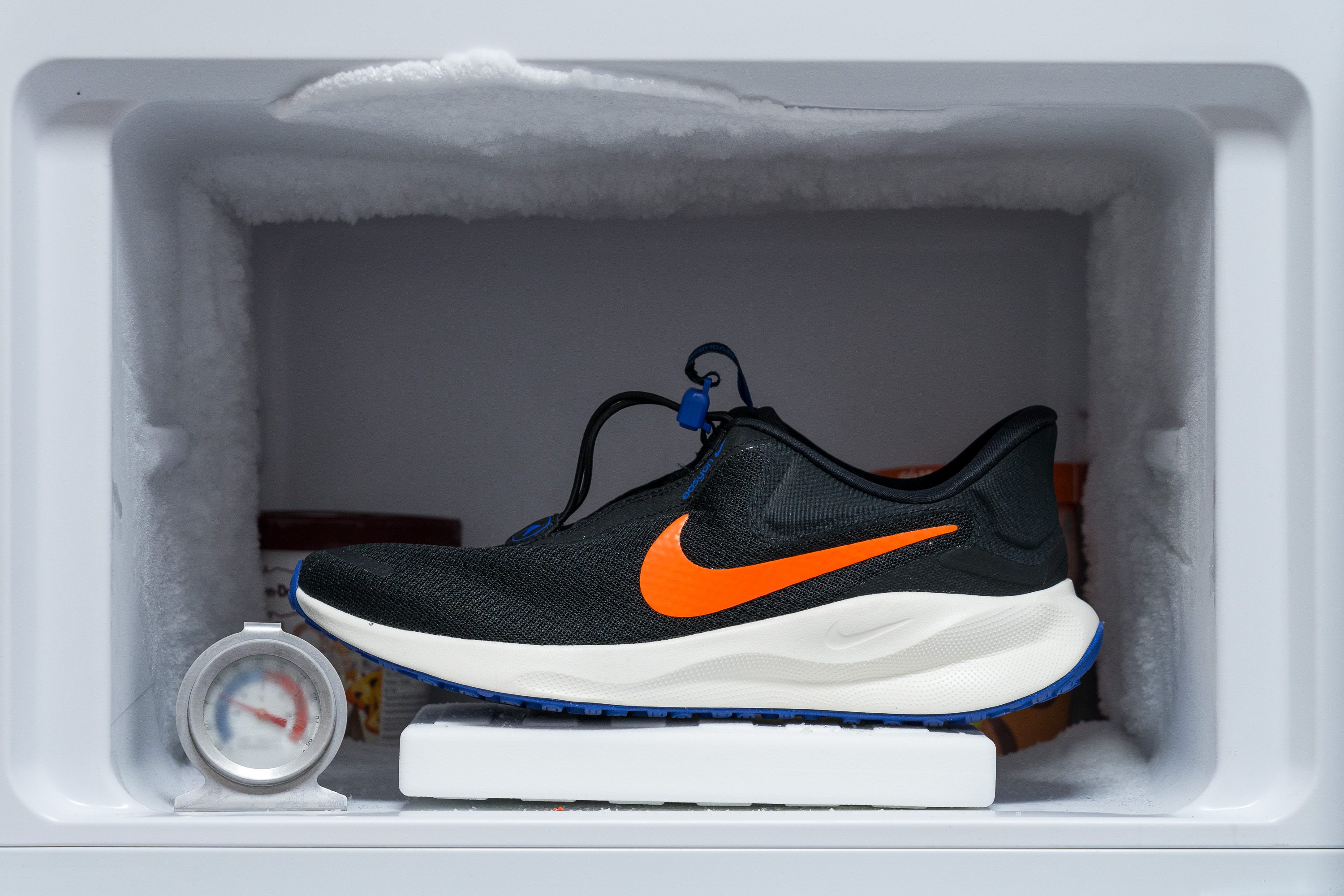
| Revolution 7 EasyOn | 30% |
| Average | 24% |
Reflective elements
We love reflective elements, but in budget-friendly shoes, we're accustomed to not finding them. These models need to fit within a strict budget, so while they won’t glow in the dark, we completely understand.
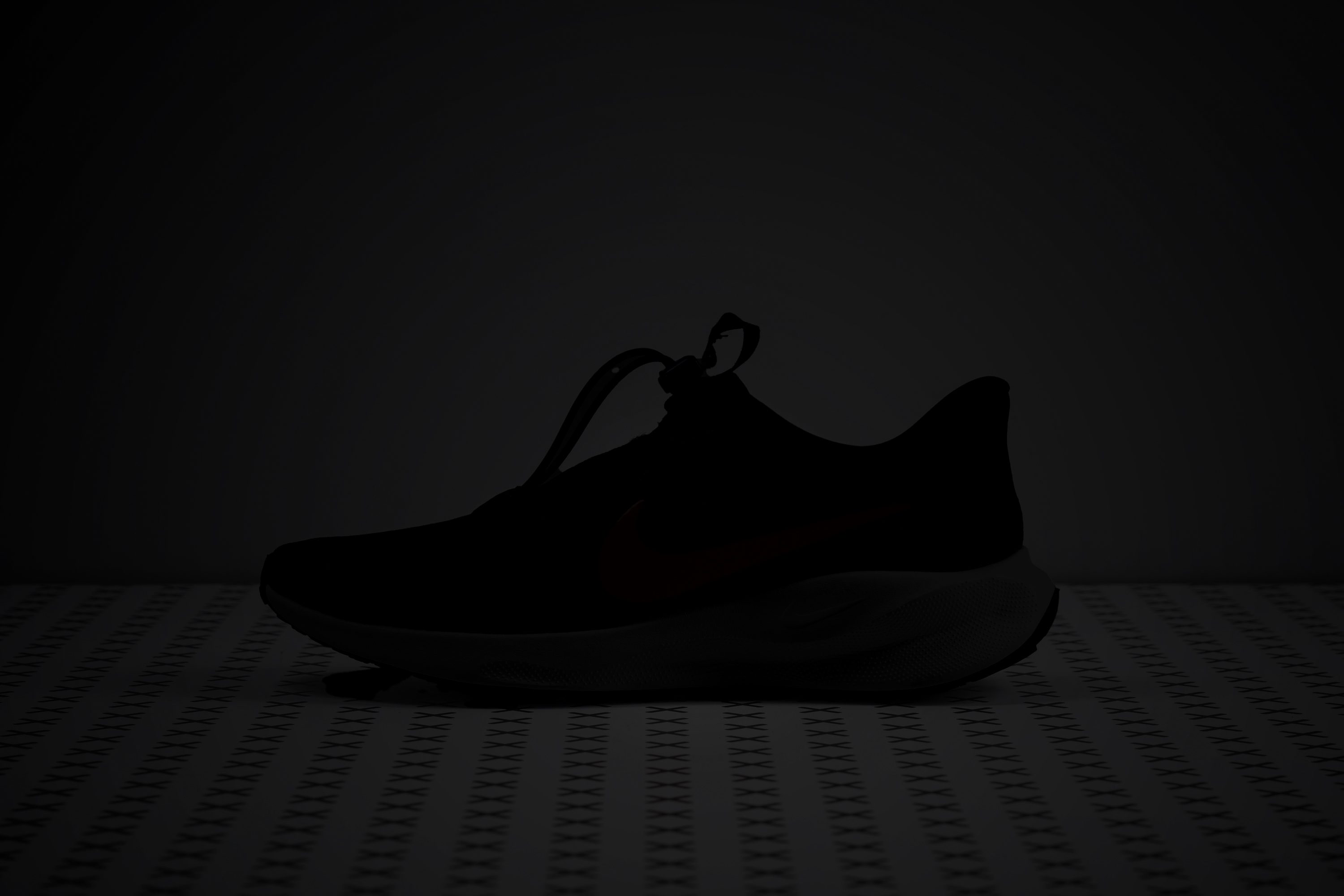
| Revolution 7 EasyOn | No |
Tongue padding
The primary reason the EasyOn version is lighter than the regular Revolution 7 lies in its streamlined tongue design. At just 7.9 mm—2.2 mm thinner than the standard version—it offers sufficient comfort without unnecessary bulk.
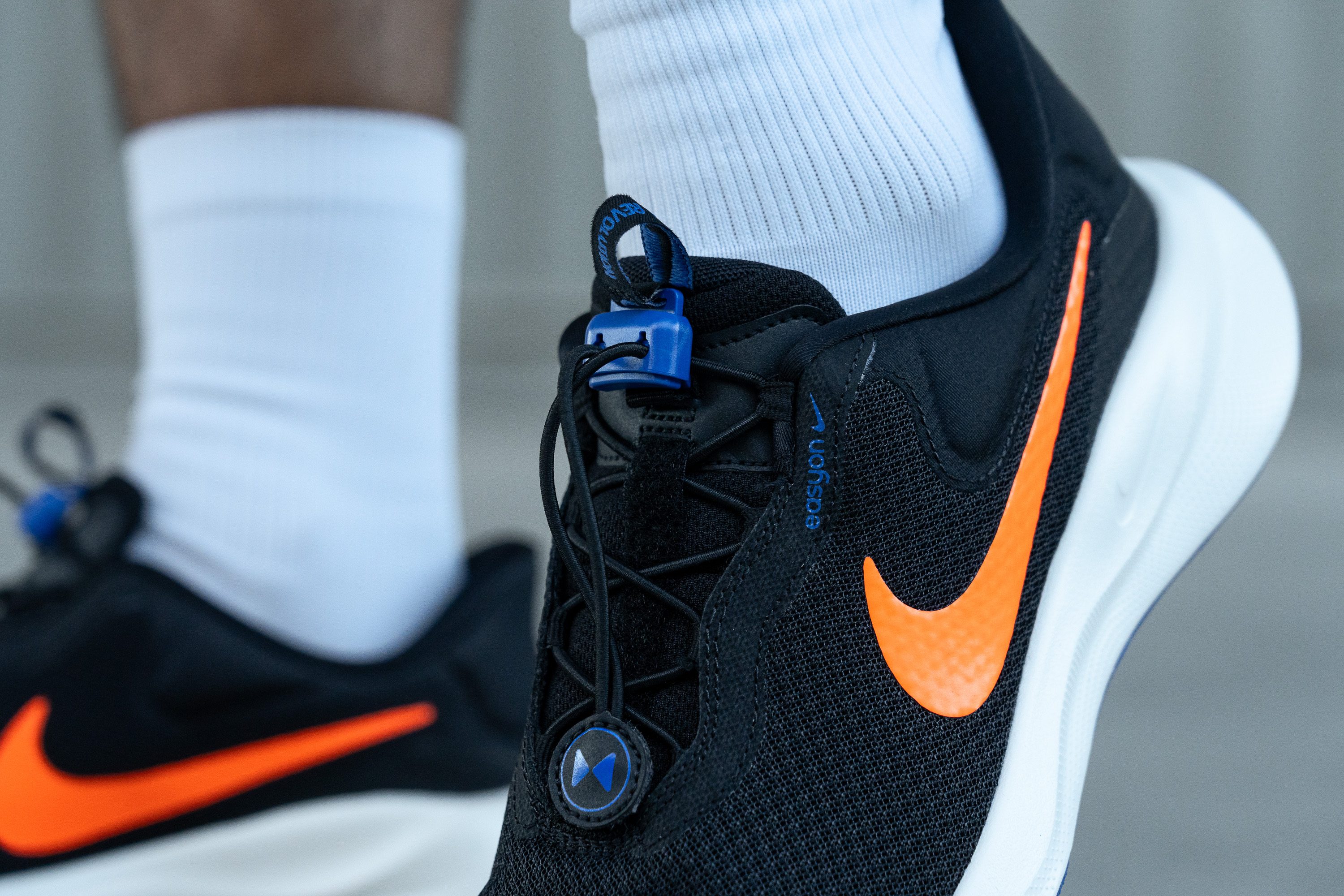
In our view, this thinner tongue complements the EasyOn system perfectly. Because the elastic laces create minimal pressure, there’s less need for extra padding.
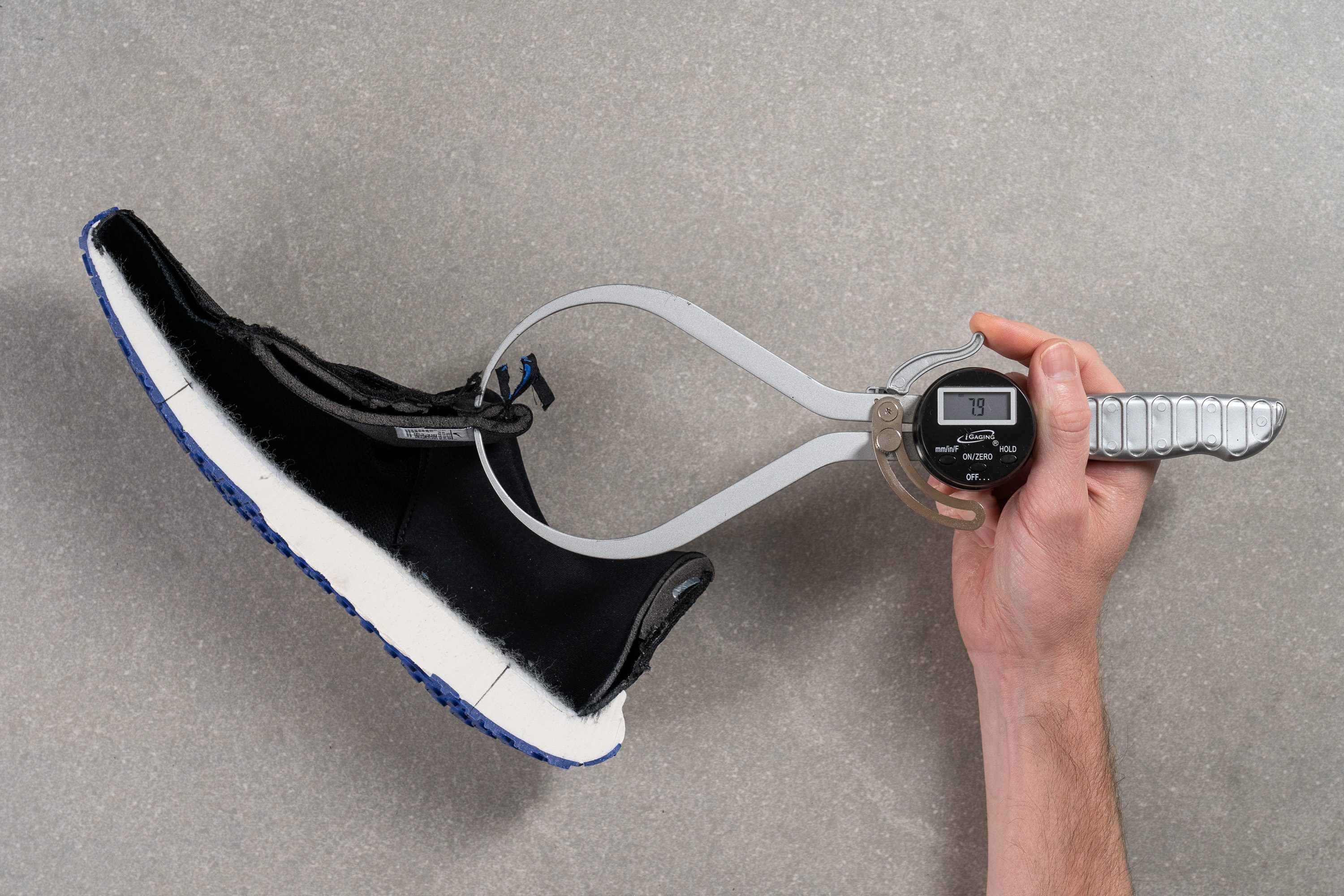
| Revolution 7 EasyOn | 7.9 mm |
| Average | 5.8 mm |
Tongue: gusset type
The tongue is fully gusseted and securely attached to the sides, but unlike the Pegasus EasyOn, this design allows for greater movement.

| Revolution 7 EasyOn | Both sides (full) |
Price
We expected Nike to charge a bit more for the EasyOn system, but they kept the price consistent with the standard model—a thoughtful touch we appreciate. This lets users choose between both versions purely based on features, not price.
| Revolution 7 EasyOn | $70 |
Heel tab
The Revolution 7 EasyOn lacks a heel tab at the back, keeping in line with the standard model and other EasyOn designs—no need for it!
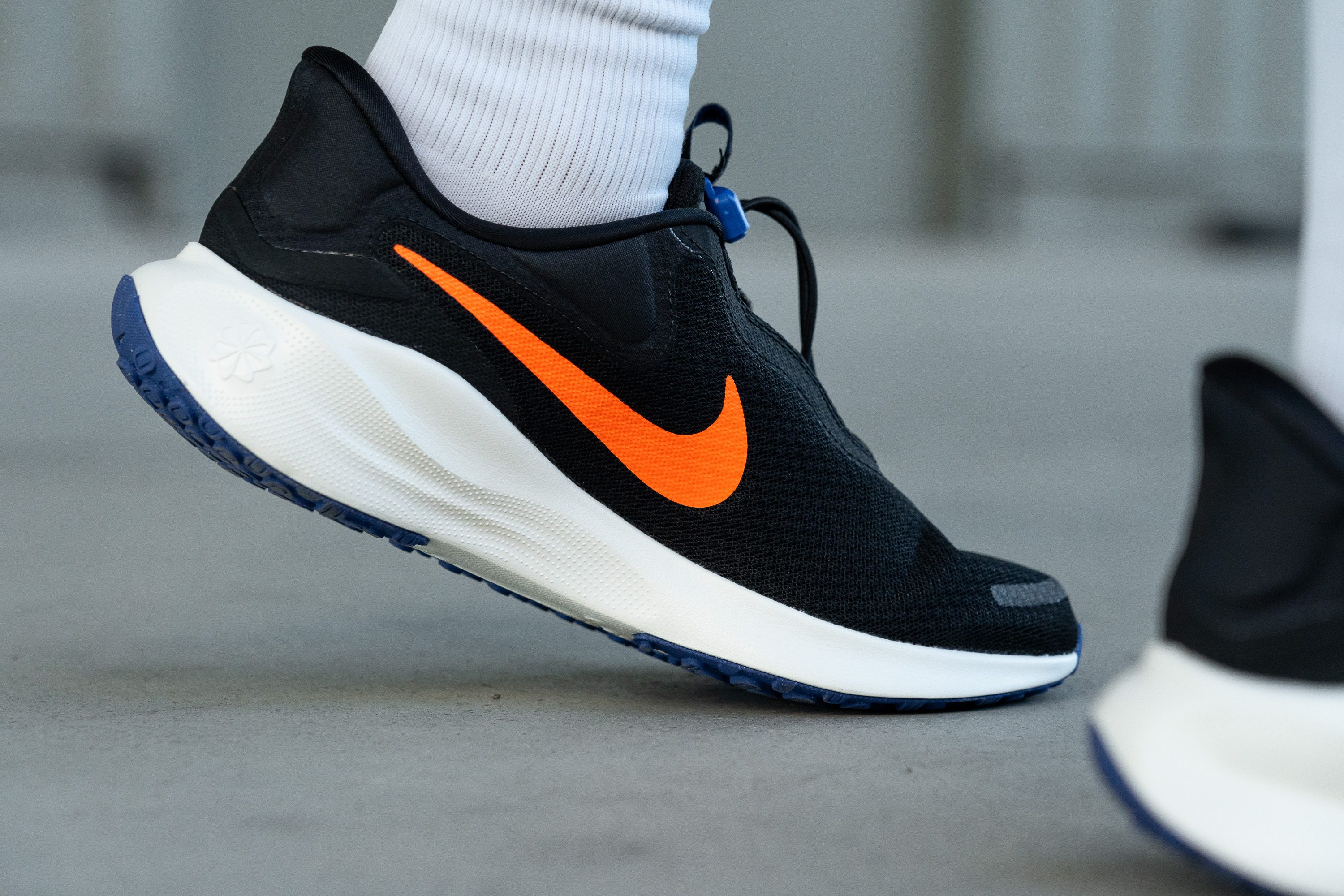
| Revolution 7 EasyOn | None |
Lacing System
The Revolution 7 EasyOn, much like its premium Pegasus EasyOn counterpart, includes a convenient one-hand lacing system. A gentle pull on the elastic laces, followed by attaching them to the Velcro strap, and you’re ready to go. It looks easy—and it truly is.
Removing the shoe is just as effortless. Pull the tongue tab to release, grip the heel with one hand, and slide your foot out. Simple as 1-2-3.

